Paul van Yperen's Blog, page 276
April 1, 2018
Lana Morris
Lana Morris (1930-1998) was a stylish and gifted British actress who appeared in films during the late 1940s and 1950s and continued her career on stage and television. She is best known for her two comedies with Norman Wisdom, Trouble in Store (1953) and Man of the Moment (1955).
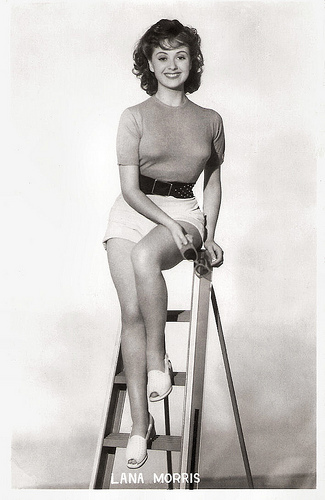
British postcard by F.S., no. 26. Caption: "Provocative Lana Morris who plays the frivolous and fascinating Bouncey Bunnington in Two Cities Gaiety Girl comedy Trottie True."
Love interest
Lana Morris was born Averil Maureen Anita Morris in Ruislip, England, in 1930.
She made her stage debut as a dancer in A Midsummer Night's Dream at the Open Air Theatre in Regent's Park, London. She changed her name to Lana Morris shortly before film producer Herbert Wilcox cast her as a cockney maid in the smash hit Spring in Park Lane (Herbert Wilcox, 1948) with Anna Neagle .
In 1948 she appeared in the British comedy It's Hard to Be Good (Jeffrey Dell, 1948) with Jimmy Hanley and Anne Crawford. Supporting parts followed in such films as the popular drama The Weaker Sex (Roy Ward Baker, 1948) with Ursula Jeans, the musical comedy film Trottie True (Brian Desmond Hurst, 1949) starring Jean Kent , and the comedy The Chiltern Hundreds (John Paddy Carstairs, 1949) with Cecil Parker and Davd Tomlinson.
In 1950 she appeared in the West End in the farce Don't Lose Your Head. During the 1950s followed supporting roles in the historical drama The Reluctant Widow (Bernard Knowles, 1950) starring Jean Kent , and the British-Italian drama A Tale of Five Cities (1951) directed by Romolo Marcellini and five other directors. The five cities cited in the title are: Rome, Paris, Berlin, London, and Vienna.
She was the love interest of Norman Wisdom in the box-office hit Trouble in Store (John Paddy Carstairs, 1953). For his cinema debut as a department store clerk, Wisdom won a BAFTA Award for Most Promising Newcomer. The film was the second most popular at the British box office in 1954. First was Doctor in the House (Ralph Thomas, 1954) with Dirk Bogarde .
She reunited with Wisdom for Man of the Moment (John Paddy Carstairs, 1955), also with Belinda Lee . Morris also appeared in several low budget crime films, such as No Trees in the Street (J. Lee Thompson, 1959) with Sylvia Sims.
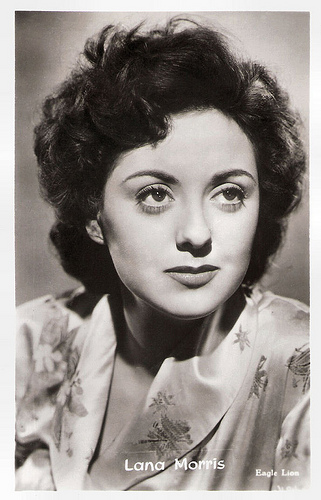
Dutch card. Photo: Eagle Lion.
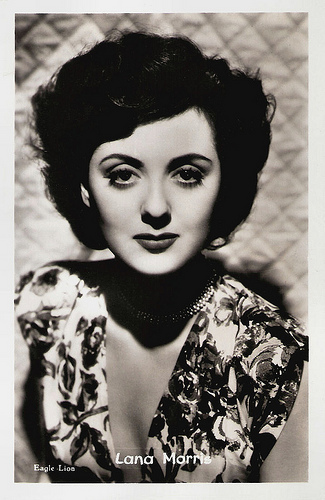
Dutch card. Photo: Eagle Lion.
Shut Your Eyes and Think of England
During the 1960s, Lana Morris mainly worked for television. She was a popular television panellist.
Morris worked with Roger Moore in The Saint (1962-1969), appearing on the cover of an early 1960s tie-in reprinting of the novel The Saint in New York.
She played the role of Helene in the popular TV series The Forsyte Saga (David Giles, James Cellan Jones, 1967), based on of John Galsworthy's series of The Forsyte Saga novels.
Back on stage in 1967 she co-starred with Gladys Cooper in Wait Until Dark and other West End hits included Play On With Love (1970) and the long running comedy Move Over, Mrs Markham (1971) in which she appeared with Moira Lister and Cicely Courtneidge .
In 1969, she appeared in her final film, the thriller I start counting (David Greene, 1970) with Jenny Agutter. In 1978 she starred in Shut Your Eyes and Think of England and in 1983 she took over from Judi Dench in the touring production of Pack of Lies.
From 1953 to 1978 (his death), she was married to the BBC executive Ronnie Waldman. While appearing in the TV program, Kaleidoscope, she had met Waldman, who went on to become the head of BBC Light Entertainment.
During the 1980s she returned to television in programs such as Howards Way and Inspector Morse.
In 1998, Lana Morris died of a heart attack in Windsor, Berkshire aged 68 and was survived by her son. Prior to her sudden death she had completed just one performance of the play Dangerous to Know at the Theatre Royal, Windsor, in which she had appeared with Michael Praed and Rula Lenska. An understudy was found at short notice and an announcement was made before the curtain on the second night by producer Bill Kenright.
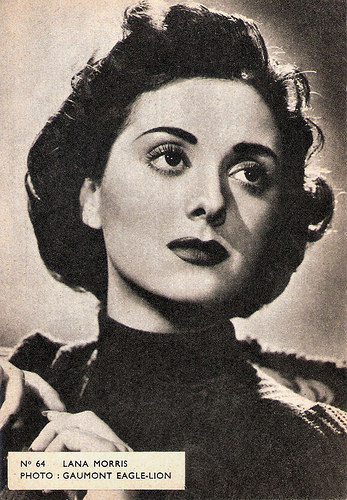
Belgian collectors card, no. 64. Photo: Gaumont Eagle-Lion.
Sources: Wikipedia and .

British postcard by F.S., no. 26. Caption: "Provocative Lana Morris who plays the frivolous and fascinating Bouncey Bunnington in Two Cities Gaiety Girl comedy Trottie True."
Love interest
Lana Morris was born Averil Maureen Anita Morris in Ruislip, England, in 1930.
She made her stage debut as a dancer in A Midsummer Night's Dream at the Open Air Theatre in Regent's Park, London. She changed her name to Lana Morris shortly before film producer Herbert Wilcox cast her as a cockney maid in the smash hit Spring in Park Lane (Herbert Wilcox, 1948) with Anna Neagle .
In 1948 she appeared in the British comedy It's Hard to Be Good (Jeffrey Dell, 1948) with Jimmy Hanley and Anne Crawford. Supporting parts followed in such films as the popular drama The Weaker Sex (Roy Ward Baker, 1948) with Ursula Jeans, the musical comedy film Trottie True (Brian Desmond Hurst, 1949) starring Jean Kent , and the comedy The Chiltern Hundreds (John Paddy Carstairs, 1949) with Cecil Parker and Davd Tomlinson.
In 1950 she appeared in the West End in the farce Don't Lose Your Head. During the 1950s followed supporting roles in the historical drama The Reluctant Widow (Bernard Knowles, 1950) starring Jean Kent , and the British-Italian drama A Tale of Five Cities (1951) directed by Romolo Marcellini and five other directors. The five cities cited in the title are: Rome, Paris, Berlin, London, and Vienna.
She was the love interest of Norman Wisdom in the box-office hit Trouble in Store (John Paddy Carstairs, 1953). For his cinema debut as a department store clerk, Wisdom won a BAFTA Award for Most Promising Newcomer. The film was the second most popular at the British box office in 1954. First was Doctor in the House (Ralph Thomas, 1954) with Dirk Bogarde .
She reunited with Wisdom for Man of the Moment (John Paddy Carstairs, 1955), also with Belinda Lee . Morris also appeared in several low budget crime films, such as No Trees in the Street (J. Lee Thompson, 1959) with Sylvia Sims.

Dutch card. Photo: Eagle Lion.

Dutch card. Photo: Eagle Lion.
Shut Your Eyes and Think of England
During the 1960s, Lana Morris mainly worked for television. She was a popular television panellist.
Morris worked with Roger Moore in The Saint (1962-1969), appearing on the cover of an early 1960s tie-in reprinting of the novel The Saint in New York.
She played the role of Helene in the popular TV series The Forsyte Saga (David Giles, James Cellan Jones, 1967), based on of John Galsworthy's series of The Forsyte Saga novels.
Back on stage in 1967 she co-starred with Gladys Cooper in Wait Until Dark and other West End hits included Play On With Love (1970) and the long running comedy Move Over, Mrs Markham (1971) in which she appeared with Moira Lister and Cicely Courtneidge .
In 1969, she appeared in her final film, the thriller I start counting (David Greene, 1970) with Jenny Agutter. In 1978 she starred in Shut Your Eyes and Think of England and in 1983 she took over from Judi Dench in the touring production of Pack of Lies.
From 1953 to 1978 (his death), she was married to the BBC executive Ronnie Waldman. While appearing in the TV program, Kaleidoscope, she had met Waldman, who went on to become the head of BBC Light Entertainment.
During the 1980s she returned to television in programs such as Howards Way and Inspector Morse.
In 1998, Lana Morris died of a heart attack in Windsor, Berkshire aged 68 and was survived by her son. Prior to her sudden death she had completed just one performance of the play Dangerous to Know at the Theatre Royal, Windsor, in which she had appeared with Michael Praed and Rula Lenska. An understudy was found at short notice and an announcement was made before the curtain on the second night by producer Bill Kenright.

Belgian collectors card, no. 64. Photo: Gaumont Eagle-Lion.
Sources: Wikipedia and .
Published on April 01, 2018 22:00
March 31, 2018
Egon von Jordan
Handsome Austrian actor Egon von Jordan (1902-1978) appeared in 85 films between 1923 and 1974. The elegant gentleman was a star in German and Austrian silent films, but later he merely appeared in supporting and small roles, including as the Austrian prime minister in the very successful Sissi-trilogy.
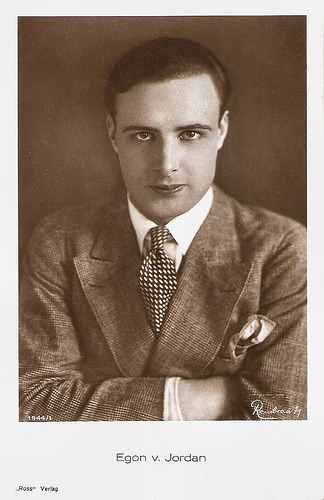
German postcard by Ross Verlag, no. 1944/1, 1927-1928. Photo: Rembrandt.
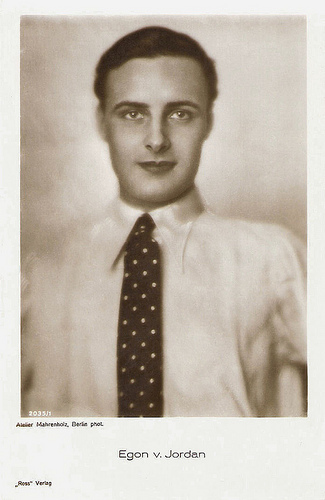
German postcard by Ross Verlag, no. 2035/1, 1927-1928. Photo: Atelier Mahrenholz, Berlin.
Perfect Gentleman
Egon von Jordan was born Egon Leopold Christian Jordan in Schloss Dux, Austria-Hungary (now Duchcov, Czech Republic) in 1902.
He studied law at the University of Vienna for four semesters and took private acting lessons with Josef Danegger. In 1921 he made his debut at the Volkstheater in Wien (Vienna).
A year later he made his first film appearance in the silent film Das Gespenst auf Mortons Schloß/The ghost on Mortons castle (Hans Homma, 1922) with Grit Haid .
A more prominent part followed in the Arthur Schnitzler adaptation Der junge Medardus/The Young Medardus (1923), directed by Michael Kertész, who later became famous in Hollywood as Michael Curtiz.
From 1925 to 1930, von Jordan was committed at the Deutsches Theater in Berlin, and in the 1930s he played in Vienna at the Theater an der Wien, and again at the Volkstheater.
Meanwhile he also starred in such silent films as Man spielt nicht mit der Liebe/Don't Play with Love (Georg Wilhelm Pabst, 1926) with Lily Damita , and Die glühende Gasse/The glowing alley (Paul Sugar, 1927) starring Hans Albers . The elegant von Jordan appeared in these films as the perfect gentleman.
After the introduction of the sound film, he went to Hollywood to star in three German language versions of MGM productions, Mordprozess Mary Dugan/The Mary Dugan Case (Arthur Robison, 1931) opposite Nora Gregor , Menschen hinter Gittern/Men behind bars (Pál Fejös, 1931) with Heinrich George , and Casanova wider willen/Parlor, Bedroom and Bath (Edward Brophy, 1931) with Françoise Rosay and Buster Keaton .
Back in Europe he appeared opposite such popular stars as Joseph Schmidt in Ein stern fällt vom himmel/A Star Fell from Heaven (Max Neufeld, 1934) and Paula Wessely in Die ganz grossen Torheiten/The quite big follies (Carl Froelich, 1937).
During the war years he refused to cooperate on Nazi propaganda films and appeared in Austrian light entertainment films such as Meine Tochter lebt in Wien/My Daughter Lives in Vienna (E.W. Emo, 1940) with Hans Moser , Wiener Blut/Vienna Blood (Willi Forst, 1942) and Musik in Salzburg/Music in Salzburg (Herbert Maisch, 1944) starring Willy Birgel .
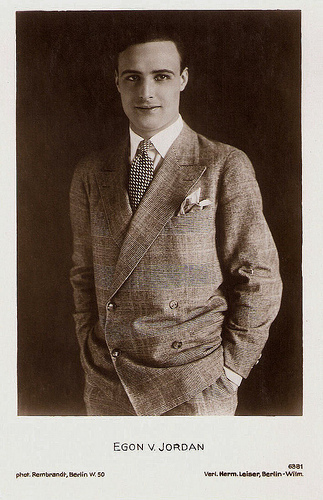
German postcard by Verl. Herm. Leiser, Berlin-Wilm., no. 6381. Photo: Rembrandt, Berlin.
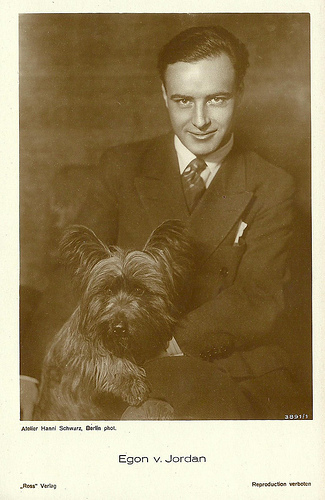
German postcard by Ross Verlag, no. 3891/1, 1928-1929. Photo: Atelier Hanni Schwarz, Berlin. Collection: Didier Hanson.
Councilors, Barons and Historical Figures
After the war, Egon von Jordan appeared at many stages in Germany and Austria.
In Italy he had a supporting part in the film Romanzo d'amore/All for love (Duilio Coletti, 1950) with Danielle Darrieux and Rossano Brazzi .
Back in Austria, he appeared in the crime film Abenteuer in Wien/Adventures in Vienna (Emil E. Reinert, 1952) with Gustav Fröhlich .
During the 1950s, he played councillors, barons and historical figures from the time of the Habsburg Empire in several Austrian films, including Eine Nacht in Venedig/A Night in Venice (Georg Wildhagen, 1953), Bel Ami (Louis Daquin, 1955) featuring Johannes Heesters , the operetta Gasparone (Karl Paryla, 1956) and Sebastian Kneipp (Wolfgang Liebeneiner, 1958) with Carl Wery.
In Hab' ich nur Deine Liebe/Am I Just Your Love (Eduard von Borsody, 1953), he appeared as composer Jacques Offenbach.
A triumph were the Sissi films, Sissi (Ernst Marischka, 1955), Sissi - die junge Kaiserin/Sissi: The Young Empress (Ernst Marischka, 1956) and Sissi - Schicksalsjahre einer Kaiserin/Sissi: The Fateful Years of an Empress (Ernst Marischka, 1957), starring Romy Schneider .
Von Jordan played the Prime Minister of Austria, Graf Arco in this popular trilogy. He and Schneider acted together again in the historical romance Katia/Adorable Sinner (Robert Siodmak, 1959), in which he played only a bit role.
In the 1960s and 1970s, he appeared in the military satire Der brave Soldat Schwejk/The Good Soldier Schweik (Axel von Ambesser, 1960) featuring Heinz Rühmann , Stadt ohne Mitleid/Town Without Pity (Gottfried Reinhardt, 1961) with Kirk Douglas , the Johannes Mario Simmel adaptation Und Jimmy ging zum Regenbogen/And Jimmy Went to the Rainbow's Foot (Alfred Vohrer, 1971) with Horst Tappert, and the monumental biography Karl May (Hans-Jürgen Syberberg, 1974), his final film.
In these years he could also be seen in several television films and series. His last appearance was in the TV film Verurteilt 1910/Sentenced in 1910 (Jörg A. Eggers, 1974) as Emperor Franz Joseph.
Egon von Jordan passed away anonymously in Vienna in 1978. He was 76.
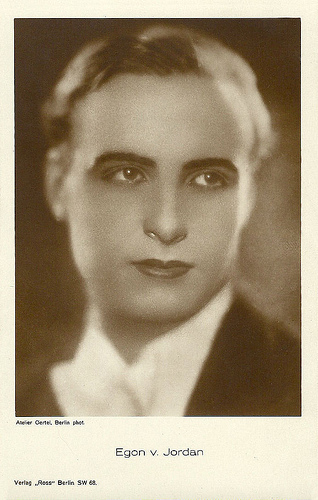
German postcard by Ross Verlag, Berlin. Photo: Atelier Oertel, Berlin.
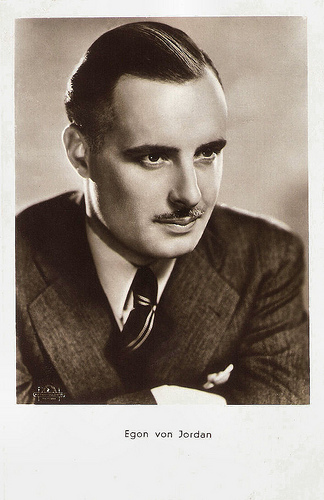
Austrian postcard by Iris-Verlag, no. 6042. Photo: Metro-Goldwyn-Mayer. In 1931, Egon von Jordan appeared in three alternative language versions of MGM productions, including the Buster Keaton comedy Casanova wider Willen (Edward Brophy, 1931), the German language version of Parlor, Bedroom and Bath (Edward Sedgwick, 1931).
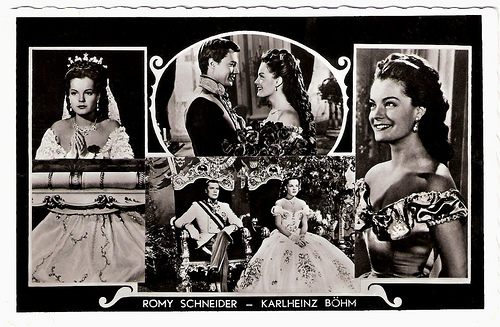
Dutch postcard by N.V. Int. Filmpers (I.F.P.), Amsterdam, no. 1027.
Sources: Philippe Pelletier (Ciné-Artistes - French), Thomas Staedeli (Cyranos), Wikipedia (English and German) and .

German postcard by Ross Verlag, no. 1944/1, 1927-1928. Photo: Rembrandt.

German postcard by Ross Verlag, no. 2035/1, 1927-1928. Photo: Atelier Mahrenholz, Berlin.
Perfect Gentleman
Egon von Jordan was born Egon Leopold Christian Jordan in Schloss Dux, Austria-Hungary (now Duchcov, Czech Republic) in 1902.
He studied law at the University of Vienna for four semesters and took private acting lessons with Josef Danegger. In 1921 he made his debut at the Volkstheater in Wien (Vienna).
A year later he made his first film appearance in the silent film Das Gespenst auf Mortons Schloß/The ghost on Mortons castle (Hans Homma, 1922) with Grit Haid .
A more prominent part followed in the Arthur Schnitzler adaptation Der junge Medardus/The Young Medardus (1923), directed by Michael Kertész, who later became famous in Hollywood as Michael Curtiz.
From 1925 to 1930, von Jordan was committed at the Deutsches Theater in Berlin, and in the 1930s he played in Vienna at the Theater an der Wien, and again at the Volkstheater.
Meanwhile he also starred in such silent films as Man spielt nicht mit der Liebe/Don't Play with Love (Georg Wilhelm Pabst, 1926) with Lily Damita , and Die glühende Gasse/The glowing alley (Paul Sugar, 1927) starring Hans Albers . The elegant von Jordan appeared in these films as the perfect gentleman.
After the introduction of the sound film, he went to Hollywood to star in three German language versions of MGM productions, Mordprozess Mary Dugan/The Mary Dugan Case (Arthur Robison, 1931) opposite Nora Gregor , Menschen hinter Gittern/Men behind bars (Pál Fejös, 1931) with Heinrich George , and Casanova wider willen/Parlor, Bedroom and Bath (Edward Brophy, 1931) with Françoise Rosay and Buster Keaton .
Back in Europe he appeared opposite such popular stars as Joseph Schmidt in Ein stern fällt vom himmel/A Star Fell from Heaven (Max Neufeld, 1934) and Paula Wessely in Die ganz grossen Torheiten/The quite big follies (Carl Froelich, 1937).
During the war years he refused to cooperate on Nazi propaganda films and appeared in Austrian light entertainment films such as Meine Tochter lebt in Wien/My Daughter Lives in Vienna (E.W. Emo, 1940) with Hans Moser , Wiener Blut/Vienna Blood (Willi Forst, 1942) and Musik in Salzburg/Music in Salzburg (Herbert Maisch, 1944) starring Willy Birgel .

German postcard by Verl. Herm. Leiser, Berlin-Wilm., no. 6381. Photo: Rembrandt, Berlin.

German postcard by Ross Verlag, no. 3891/1, 1928-1929. Photo: Atelier Hanni Schwarz, Berlin. Collection: Didier Hanson.
Councilors, Barons and Historical Figures
After the war, Egon von Jordan appeared at many stages in Germany and Austria.
In Italy he had a supporting part in the film Romanzo d'amore/All for love (Duilio Coletti, 1950) with Danielle Darrieux and Rossano Brazzi .
Back in Austria, he appeared in the crime film Abenteuer in Wien/Adventures in Vienna (Emil E. Reinert, 1952) with Gustav Fröhlich .
During the 1950s, he played councillors, barons and historical figures from the time of the Habsburg Empire in several Austrian films, including Eine Nacht in Venedig/A Night in Venice (Georg Wildhagen, 1953), Bel Ami (Louis Daquin, 1955) featuring Johannes Heesters , the operetta Gasparone (Karl Paryla, 1956) and Sebastian Kneipp (Wolfgang Liebeneiner, 1958) with Carl Wery.
In Hab' ich nur Deine Liebe/Am I Just Your Love (Eduard von Borsody, 1953), he appeared as composer Jacques Offenbach.
A triumph were the Sissi films, Sissi (Ernst Marischka, 1955), Sissi - die junge Kaiserin/Sissi: The Young Empress (Ernst Marischka, 1956) and Sissi - Schicksalsjahre einer Kaiserin/Sissi: The Fateful Years of an Empress (Ernst Marischka, 1957), starring Romy Schneider .
Von Jordan played the Prime Minister of Austria, Graf Arco in this popular trilogy. He and Schneider acted together again in the historical romance Katia/Adorable Sinner (Robert Siodmak, 1959), in which he played only a bit role.
In the 1960s and 1970s, he appeared in the military satire Der brave Soldat Schwejk/The Good Soldier Schweik (Axel von Ambesser, 1960) featuring Heinz Rühmann , Stadt ohne Mitleid/Town Without Pity (Gottfried Reinhardt, 1961) with Kirk Douglas , the Johannes Mario Simmel adaptation Und Jimmy ging zum Regenbogen/And Jimmy Went to the Rainbow's Foot (Alfred Vohrer, 1971) with Horst Tappert, and the monumental biography Karl May (Hans-Jürgen Syberberg, 1974), his final film.
In these years he could also be seen in several television films and series. His last appearance was in the TV film Verurteilt 1910/Sentenced in 1910 (Jörg A. Eggers, 1974) as Emperor Franz Joseph.
Egon von Jordan passed away anonymously in Vienna in 1978. He was 76.

German postcard by Ross Verlag, Berlin. Photo: Atelier Oertel, Berlin.

Austrian postcard by Iris-Verlag, no. 6042. Photo: Metro-Goldwyn-Mayer. In 1931, Egon von Jordan appeared in three alternative language versions of MGM productions, including the Buster Keaton comedy Casanova wider Willen (Edward Brophy, 1931), the German language version of Parlor, Bedroom and Bath (Edward Sedgwick, 1931).

Dutch postcard by N.V. Int. Filmpers (I.F.P.), Amsterdam, no. 1027.
Sources: Philippe Pelletier (Ciné-Artistes - French), Thomas Staedeli (Cyranos), Wikipedia (English and German) and .
Published on March 31, 2018 22:00
March 30, 2018
Franco Andrei
Italian actor Franco Andrei (1925) played the hunky Latin lover in German and Italian comedies of the 1950s. In the 1960s, he appeared as a secret agent in several Eurospy-films and in the TV series Mission: Impossible.
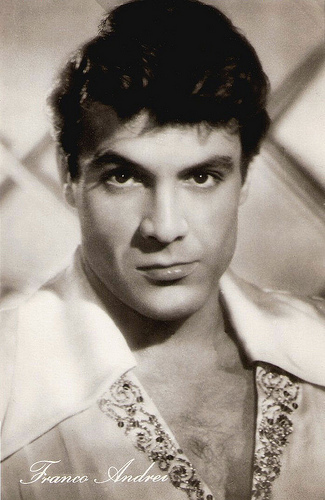
East-German postcard by VEB Progress Film-Vertrieb, no. 440, 1957. Retail price: 0,20 DM. Photo: Standard-Film.
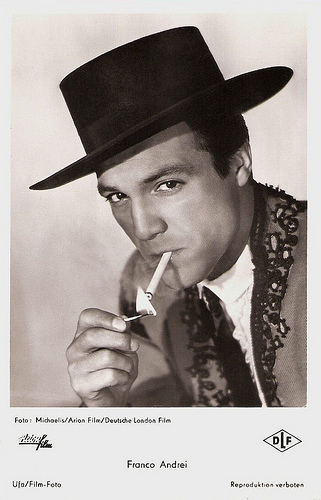
German postcard by Universum-Film AG (UFA/Film-Foto), Berlin-Tempelhof, no. FK 1144. Photo: Michaelis / Arian Film / Deutsche London Film (DLF). Publicity still for Tanz in der Sonne/Dance in the Sun (Géza von Cziffra, 1954)
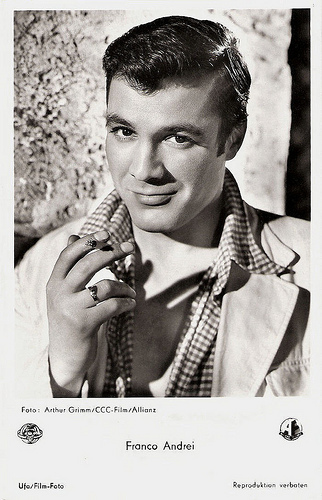
German postcard by Universum-Film AG (UFA/Film-Foto), Berlin-Tempelhof, no. FK 1459. Photo: Arthur Grimm / CCC-Film / Allianz Film. Publicity still for Stern von Rio/Star from Rio (Kurt Neumann, 1955).
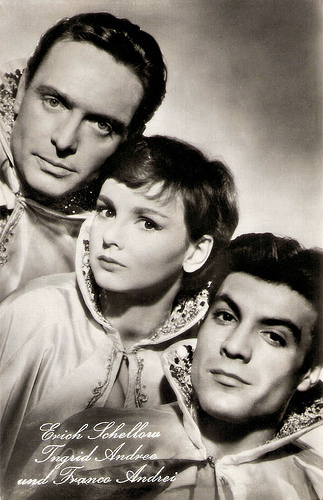
East-German postcard by VEB Progress Film-Vertrieb, Berlin, no. 222, 1957. Photo: Standard-film, Wien. Publicity still for Drei vom Variété/Three from Variety (Kurt Neumann, 1954) with Erich Schellow and Ingrid Andree .
Italian Lover
Franco Andrei was born in Italy in 1925.
He made his film debut in the early 1950s. In 1953, he appeared as the Italian lover of Maria Schell in the German comedy Tagebuch einer Verliebten/The Diary of a Married Woman (Josef von Báky, 1053) with O.W. Fischer as her husband. The film was based on one of the popular novels by Johannes Mario Simmel.
Andrei played another Latin lover – this time a Spanish one - in the musical Tanz in der Sonne/Dance in the Sun (Géza von Cziffra, 1954) with French actress Cécile Aubry . He also appeared in the German crime drama Drei vom Varieté/Three from Variety (Kurt Neumann, 1954) with Ingrid Andree , and the German-Italian adventure film Stern von Rio/Star from Rio (Kurt Neumann, 1955) with Johannes Heesters .
Andrei also appeared in Italian films, including the romantic adventure film La capinera del mulino/The Blackhead of the Mill (Angio Zane, 1956) with Marisa Belli, the melodrama Suprema confessione/Supreme Confession (Sergio Corbucci, 1957) starring Anna Maria Ferrero , and the musical Come te movi, te fulmino!/Move and I'll Shoot (Mario Mattoli, 1958) with Giovanna Ralli .
He also played a supporting part in the French film Sait-on jamais.../No Sun in Venice (Roger Vadim, 1957) about a cute and amoral (and Vadim’s favourite type of) French girl ( Francoise Arnoul ) living in a sumptuous Venetian palazzo. Andrei was one of the handsome guys swarming around her.
At IMDb, Hal Erickson writes: “Vadim’s second directorial project was Sait-On Jamais, which was released in English-speaking countries as Does One Ever Know and No Sun in Venice. Set in Italy, this romantic suspenser is inventively paced to the musical improvisations of the Modern Jazz Quartet.”
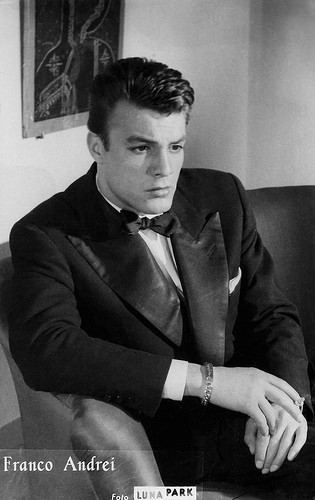
Italian postcard by Farrania. Photo: Luna Park.
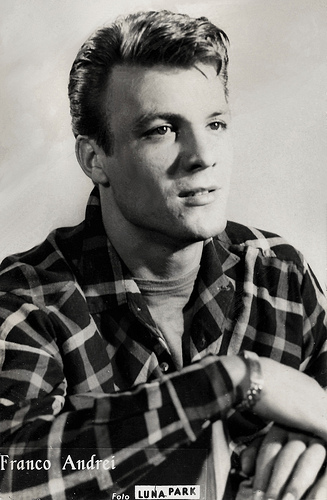
Italian postcard by Farrania. Photo: Luna Park.
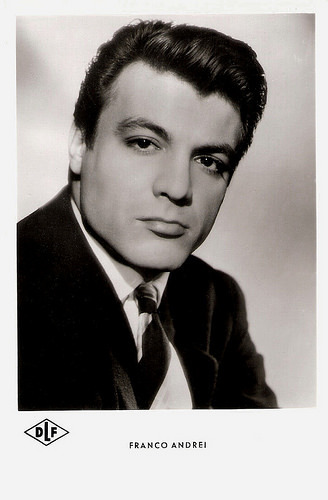
German postcard by Kunst und Bild, Berlin, no. A 1122. Photo: Deutsche London Film.
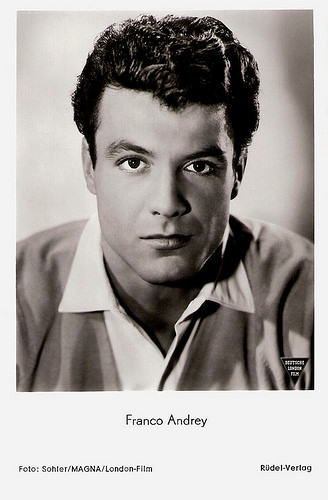
German postcard by Rüdel-Verlag, Hamburg-Bergedorf, no. 859. Photo: Sohler / MAGNA / London-Film. Publicity still for Tagebuch einer Verliebten/The Diary of a Married Woman (Josef von Báky, 1953).
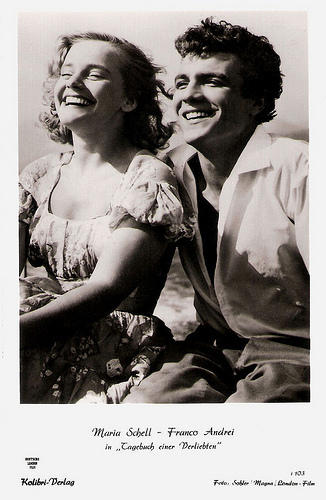
German postcard by Kolibri-Verlag, no. I 103. Photo: Sohler / Magna / London-Film. Publicity still for Tagebuch einer Verliebten/The Diary of a Married Woman (Josef von Báky, 1953) with Maria Schell .
Secret Agent No. 3
Franco Andrei continued his international film career in the 1960s, although his appearances became rarer.
He was again the stereotypical Latin lover in the romantic comedy Schick deine Frau nicht nach Italien/Do Not Send Your Wife to Italy (Hans Grimm, 1960) starring Marianne Hold and Claus Biederstaedt .
He had a supporting part in the American production The Big Show (James B. Clark, 1961), which was filmed on location in Munich, Germany. The film’s main claim to fame was that it was the last major production starring aqua diva Esther Williams.
As Frank Andrews, Andrei played a secondary character in the Eurospy film Agente 3S3: Passaporto per l'inferno/Agent 3S3: Passport to Hell (Sergio Sollima, 1965). (The meaning of the codename Agent 3S3 is Secret Agent No. 3 of the 3rd Special Division). He returned in another Eurospy thriller by director Sollima, Requiem per un agente segreto/Requiem for a Secret Agent (Sergio Sollima, 1966) starring Stewart Granger .
His best known film is probably the Sci-Fi horror film Terrore nello spazio/Planet of the Vampires (1965) by cult director Mario Bava. At IMDb , reviewer In-the-fade writes: “Mario Bava does it again. The crystal colours, eerie atmosphere and evocative visuals are downright dazzling and haunting in this low-budget Italian Sci-fi outing. Never have I been disappointed in these technical aspects while experiencing the master at work. Many have mentioned it and the influences / similarities to Ridley Scott's 'Alien (1979)' ultimately sticks out.”
Robert Firsching at AllMovie adds: “This classic blend of science-fiction and horror belies its extremely low budget with buckets of atmosphere and some genuinely creepy setpieces. The story concerns the crews of two spaceships, who land on a foggy, seemingly deserted planet. What they don't know is that the planet was home to a race of vampiric aliens, who possess their minds, eventually rising from their strange, misty graves to seek human blood. Legendary director Mario Bava once again proves himself a master at atmospheric composition, using color, sound, and minimalistic sets in original and unnerving ways. Barry Sullivan stars”.
On American TV, Franco Andrei could be seen in a guest role in the popular series Mission: Impossible (1967). After the crime film Supercolpo da 7 miliardi/The 1000 Carat Diamond (Bitto Albertini, 1967) with Brad Harris , Franco Andrei’s film career virtually ended.
More than 20 years later followed his last screen credit for the German TV drama Der lange Sommer/The Long Summer (Jochen Richter, 1989).
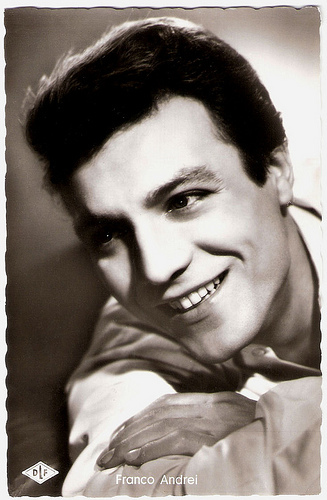
German postcard by Kolibri-Verlag, Minden-Westf., no. 1112. Photo: Standard-film / Deutsche London / Lilo.
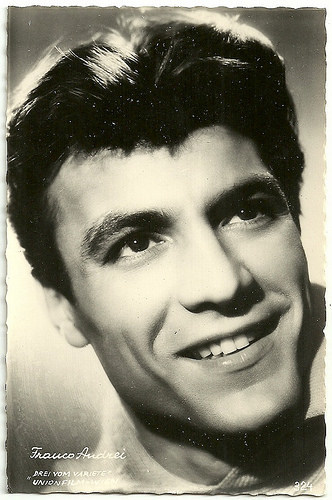
Austrian postcard by HDH Verlag (Verlag Hubmann), Vienna, no. 324. Photo: Union Film. Franco Andrei in Drei vom Variété/Three from Variety (Kurt Neumann, 1954).
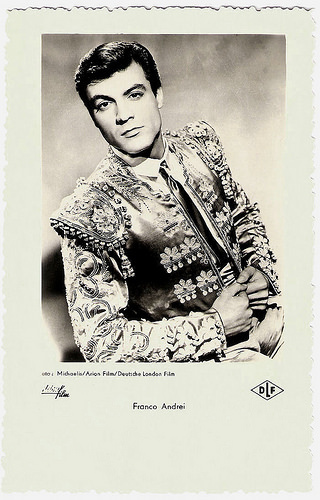
German card. Photo: Michaelis / Arion Film / Deutsche London Film. Publicity still for Tanz in der Sonne/Dancing in the sun (Géza von Cziffra, 1954).
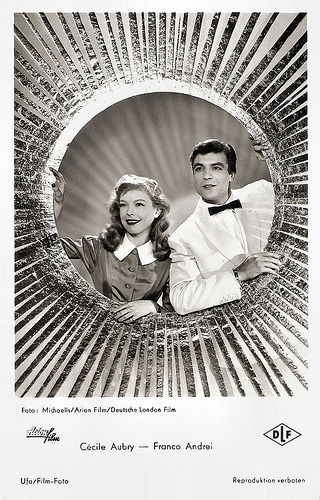
German postcard by Ufa, Berlin-Tempelhof, no. FK 1145. Photo: Michaelis / Arion Film / Deutsche London Film. Publicity still for Tanz in der Sonne/Dance in the Sun (Géza von Cziffra, 1954) with Cécile Aubry .
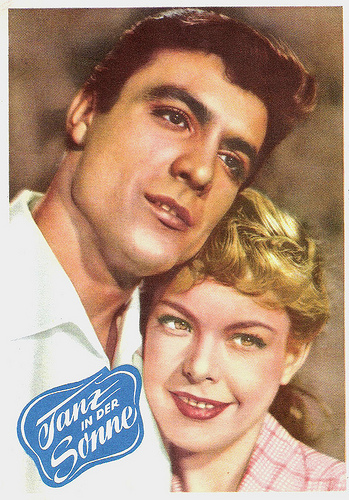
German postcard, offered by Cinema Capitole, Luxenbourg. Publicity still for Tanz in der Sonne/Dance in the Sun (Géza von Cziffra, 1954) with Cécile Aubry .
Sources: Hal Erickson (AllMovie), Robert Firsching (AllMovie), MYmovies.it (Italian), and .

East-German postcard by VEB Progress Film-Vertrieb, no. 440, 1957. Retail price: 0,20 DM. Photo: Standard-Film.

German postcard by Universum-Film AG (UFA/Film-Foto), Berlin-Tempelhof, no. FK 1144. Photo: Michaelis / Arian Film / Deutsche London Film (DLF). Publicity still for Tanz in der Sonne/Dance in the Sun (Géza von Cziffra, 1954)

German postcard by Universum-Film AG (UFA/Film-Foto), Berlin-Tempelhof, no. FK 1459. Photo: Arthur Grimm / CCC-Film / Allianz Film. Publicity still for Stern von Rio/Star from Rio (Kurt Neumann, 1955).

East-German postcard by VEB Progress Film-Vertrieb, Berlin, no. 222, 1957. Photo: Standard-film, Wien. Publicity still for Drei vom Variété/Three from Variety (Kurt Neumann, 1954) with Erich Schellow and Ingrid Andree .
Italian Lover
Franco Andrei was born in Italy in 1925.
He made his film debut in the early 1950s. In 1953, he appeared as the Italian lover of Maria Schell in the German comedy Tagebuch einer Verliebten/The Diary of a Married Woman (Josef von Báky, 1053) with O.W. Fischer as her husband. The film was based on one of the popular novels by Johannes Mario Simmel.
Andrei played another Latin lover – this time a Spanish one - in the musical Tanz in der Sonne/Dance in the Sun (Géza von Cziffra, 1954) with French actress Cécile Aubry . He also appeared in the German crime drama Drei vom Varieté/Three from Variety (Kurt Neumann, 1954) with Ingrid Andree , and the German-Italian adventure film Stern von Rio/Star from Rio (Kurt Neumann, 1955) with Johannes Heesters .
Andrei also appeared in Italian films, including the romantic adventure film La capinera del mulino/The Blackhead of the Mill (Angio Zane, 1956) with Marisa Belli, the melodrama Suprema confessione/Supreme Confession (Sergio Corbucci, 1957) starring Anna Maria Ferrero , and the musical Come te movi, te fulmino!/Move and I'll Shoot (Mario Mattoli, 1958) with Giovanna Ralli .
He also played a supporting part in the French film Sait-on jamais.../No Sun in Venice (Roger Vadim, 1957) about a cute and amoral (and Vadim’s favourite type of) French girl ( Francoise Arnoul ) living in a sumptuous Venetian palazzo. Andrei was one of the handsome guys swarming around her.
At IMDb, Hal Erickson writes: “Vadim’s second directorial project was Sait-On Jamais, which was released in English-speaking countries as Does One Ever Know and No Sun in Venice. Set in Italy, this romantic suspenser is inventively paced to the musical improvisations of the Modern Jazz Quartet.”

Italian postcard by Farrania. Photo: Luna Park.

Italian postcard by Farrania. Photo: Luna Park.

German postcard by Kunst und Bild, Berlin, no. A 1122. Photo: Deutsche London Film.

German postcard by Rüdel-Verlag, Hamburg-Bergedorf, no. 859. Photo: Sohler / MAGNA / London-Film. Publicity still for Tagebuch einer Verliebten/The Diary of a Married Woman (Josef von Báky, 1953).

German postcard by Kolibri-Verlag, no. I 103. Photo: Sohler / Magna / London-Film. Publicity still for Tagebuch einer Verliebten/The Diary of a Married Woman (Josef von Báky, 1953) with Maria Schell .
Secret Agent No. 3
Franco Andrei continued his international film career in the 1960s, although his appearances became rarer.
He was again the stereotypical Latin lover in the romantic comedy Schick deine Frau nicht nach Italien/Do Not Send Your Wife to Italy (Hans Grimm, 1960) starring Marianne Hold and Claus Biederstaedt .
He had a supporting part in the American production The Big Show (James B. Clark, 1961), which was filmed on location in Munich, Germany. The film’s main claim to fame was that it was the last major production starring aqua diva Esther Williams.
As Frank Andrews, Andrei played a secondary character in the Eurospy film Agente 3S3: Passaporto per l'inferno/Agent 3S3: Passport to Hell (Sergio Sollima, 1965). (The meaning of the codename Agent 3S3 is Secret Agent No. 3 of the 3rd Special Division). He returned in another Eurospy thriller by director Sollima, Requiem per un agente segreto/Requiem for a Secret Agent (Sergio Sollima, 1966) starring Stewart Granger .
His best known film is probably the Sci-Fi horror film Terrore nello spazio/Planet of the Vampires (1965) by cult director Mario Bava. At IMDb , reviewer In-the-fade writes: “Mario Bava does it again. The crystal colours, eerie atmosphere and evocative visuals are downright dazzling and haunting in this low-budget Italian Sci-fi outing. Never have I been disappointed in these technical aspects while experiencing the master at work. Many have mentioned it and the influences / similarities to Ridley Scott's 'Alien (1979)' ultimately sticks out.”
Robert Firsching at AllMovie adds: “This classic blend of science-fiction and horror belies its extremely low budget with buckets of atmosphere and some genuinely creepy setpieces. The story concerns the crews of two spaceships, who land on a foggy, seemingly deserted planet. What they don't know is that the planet was home to a race of vampiric aliens, who possess their minds, eventually rising from their strange, misty graves to seek human blood. Legendary director Mario Bava once again proves himself a master at atmospheric composition, using color, sound, and minimalistic sets in original and unnerving ways. Barry Sullivan stars”.
On American TV, Franco Andrei could be seen in a guest role in the popular series Mission: Impossible (1967). After the crime film Supercolpo da 7 miliardi/The 1000 Carat Diamond (Bitto Albertini, 1967) with Brad Harris , Franco Andrei’s film career virtually ended.
More than 20 years later followed his last screen credit for the German TV drama Der lange Sommer/The Long Summer (Jochen Richter, 1989).

German postcard by Kolibri-Verlag, Minden-Westf., no. 1112. Photo: Standard-film / Deutsche London / Lilo.

Austrian postcard by HDH Verlag (Verlag Hubmann), Vienna, no. 324. Photo: Union Film. Franco Andrei in Drei vom Variété/Three from Variety (Kurt Neumann, 1954).

German card. Photo: Michaelis / Arion Film / Deutsche London Film. Publicity still for Tanz in der Sonne/Dancing in the sun (Géza von Cziffra, 1954).

German postcard by Ufa, Berlin-Tempelhof, no. FK 1145. Photo: Michaelis / Arion Film / Deutsche London Film. Publicity still for Tanz in der Sonne/Dance in the Sun (Géza von Cziffra, 1954) with Cécile Aubry .

German postcard, offered by Cinema Capitole, Luxenbourg. Publicity still for Tanz in der Sonne/Dance in the Sun (Géza von Cziffra, 1954) with Cécile Aubry .
Sources: Hal Erickson (AllMovie), Robert Firsching (AllMovie), MYmovies.it (Italian), and .
Published on March 30, 2018 22:00
March 29, 2018
Rizzoli
During the dictatorship of Benito Mussolini, Rizzoli in Milan was one of the most prominent publishers of film star postcards in Italy. Director was Angelo Rizzoli, who also was a film producer. For this post we selected 15 Rizzoli postcards of 13 Italian star actresses. Typical for these postcards are the monochrome colours and the strange numbering: e.g. 1938-XVI means published in 1938, the 16th year since the reign of Benito Mussolini started in 1922.
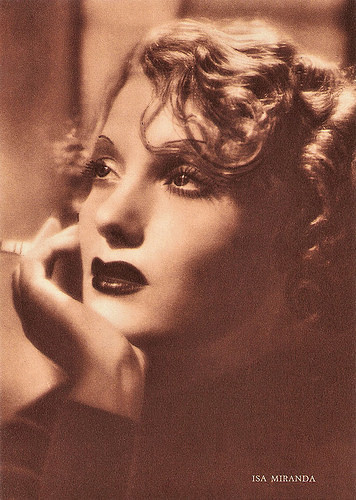
Isa Miranda . Italian postcard by Rizzoli, Milano, 1937-XV.
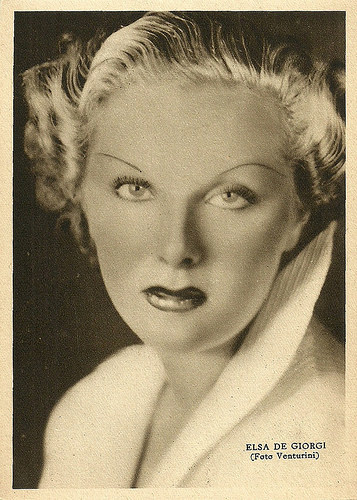
Elsa De Giorgi. Italian postcard by Rizzoli, 1940. Photo: Venturini.
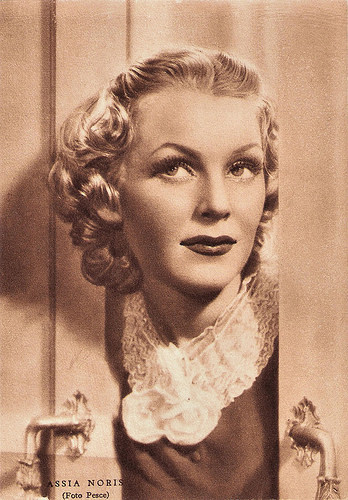
Assia Noris . Italian postcard by Rizzoli E.C., Milano, 1938-XVI. Photo: Pesce.
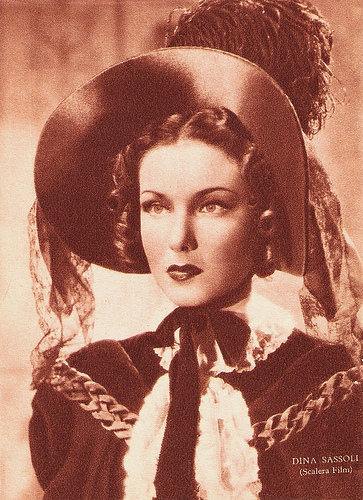
Dina Sassoli . Italian postcard by Rizzoli, Milano, 1942-XX. Photo: Scalera Film. Publicity still for Don Giovanni/Loves of Don Juan (Dino Falconi, 1942).
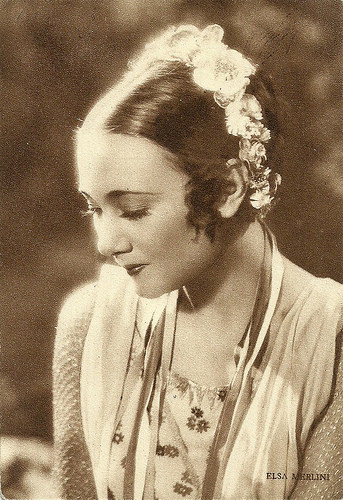
Elsa Merlini . Italian postcard by Rizzoli & Co, Milano, 1936.
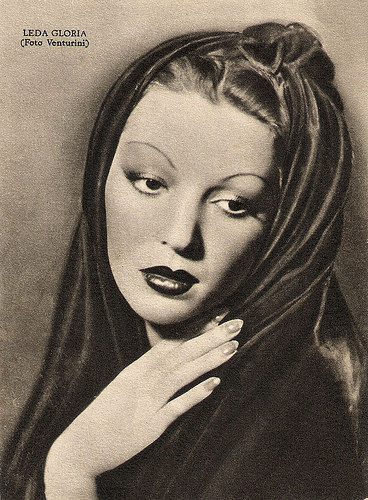
Leda Gloria . Italian postcard by Rizzoli, Milano, 1941. Sent by mail in 1943. Photo: Venturini.
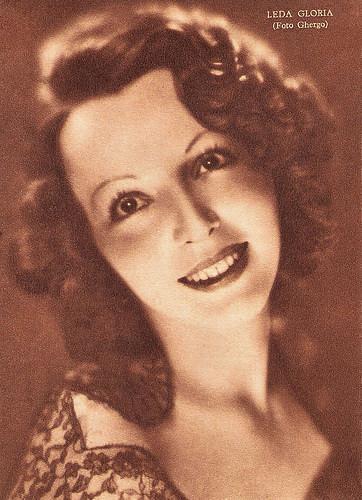
Leda Gloria . Italian postcard by Rizzoli, Milano, 1942. Photo: Ghergo.
Angelo Rizzoli
Founder of Rizzoli was Milanese publisher and film producer Angelo Rizzoli (1889-1970). Orphaned at a young age and raised in poverty, he rose to prosperity. He apprenticed in the printer trade and later became an entrepreneur in his twenties.
In 1927, he founded company A. Rizzoli & Co. (later RCS MediaGroup). In 1927 Rizzoli acquired Novella magazine, a bi-weekly primarily for women that reached a circulation of 130,000 copies, from Mondadori an independent publisher who specialised in books and magazines.
He later added several new publications. In 1949 he began publishing books including both classics and popular novels. His firm became an Italian publishing empire. Rizzoli was amongst the first producers of daily newspapers within the relatively newly established nation of Italy.
From 1934 he was also active as a film producer He had instant success with his production La signora di tutti/Everybody's Woman (Max Ophüls, 1934) starring Isa Miranda . For this film he also made a beautiful series of postcards. It was followed by the hit comedy Darò un milione/I'll Give a Million (Mario Camerini, 1935), starring Vittorio De Sica and Assia Noris .
After the war, he produced Federico Fellini's La Dolce Vita (1960) and 8½ (1963), and Michelangelo Antonioni's Il deserto rosso (1964). He also produced the controversial documentaries Mondo cane/A Dog's Life (Paolo Cavara, Gualtiero Jacopetti, Franco Prosperi, 1962) and Africa Addio/Africa Blood and Guts (Gualtiero Jacopetti, Franco Prosperi, 1966), as well as French films such as Une Parisienne (Michel Boisrond, 1957), starring Brigitte Bardot.
A museum about Angelo Rizzoli's life and career is located at Villa Arbusto within the guest house of that place, at Lacco Ameno. Within this are held 500 photographic-records or evidence of his activities taken on-set during production. The museum also holds the Pithekoussai Archaeological Museum
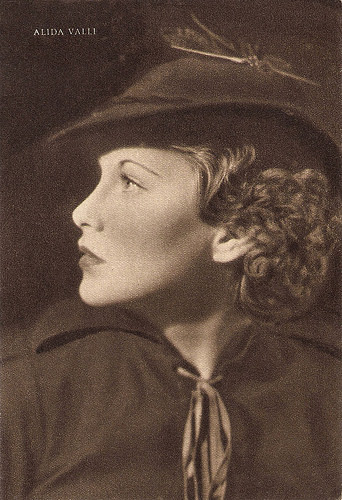
Alida Valli . Italian postcard by Rizzoli, Milano, 1939.

Alida Valli . Italian postcard by Rizzoli, Milano, 1941. Photo: Venturini.
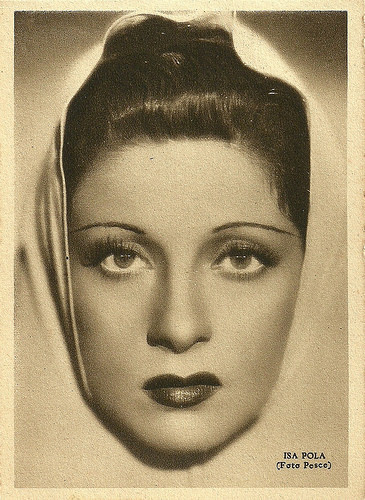
Isa Pola . Italian postcard by Rizzoli, Milano, 1940. Photo: Pesce.
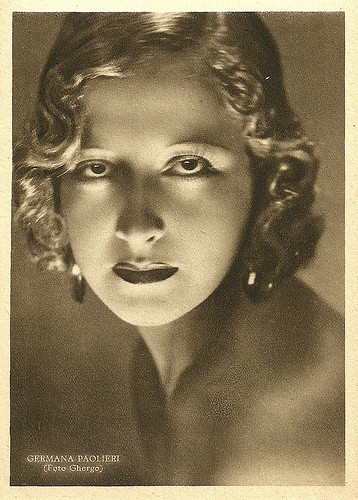
Germana Paolieri . Italian postcard by Rizzoli, Milano 1940. Photo: Ghergo.
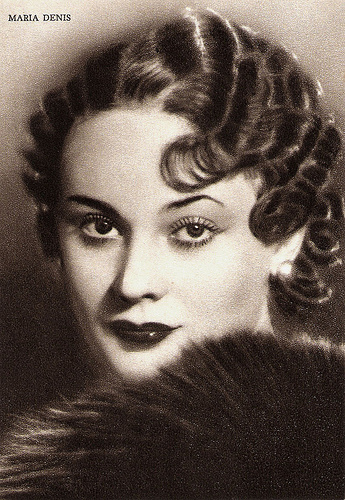
Maria Denis . Italian postcard by Rizzoli, Milano, 1936.
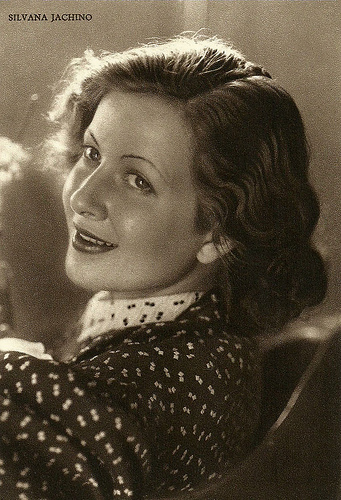
Silvana Jachino . Italian postcard by Rizzoli, Milano, 1936.
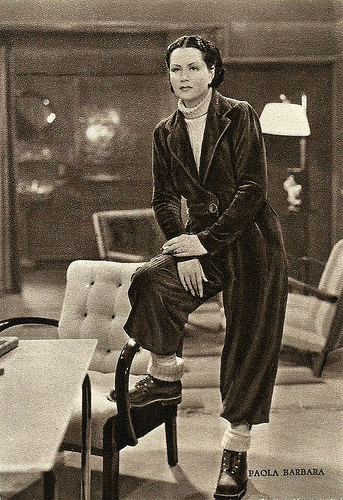
Paola Barbara . Italian postcard by Rizzoli, Milan, 1936-XV.
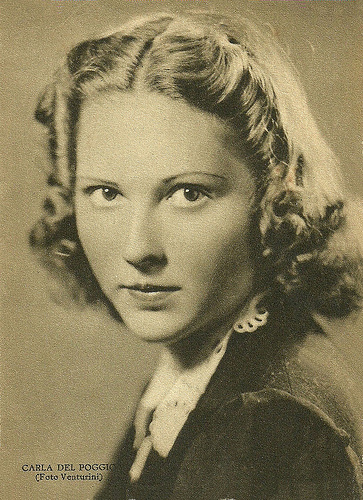
Carla Del Poggio . Italian postcard by Ed. Rizzoli, Milano, 1941. Photo: Venturini.
Sources: Wikipedia and .

Isa Miranda . Italian postcard by Rizzoli, Milano, 1937-XV.

Elsa De Giorgi. Italian postcard by Rizzoli, 1940. Photo: Venturini.

Assia Noris . Italian postcard by Rizzoli E.C., Milano, 1938-XVI. Photo: Pesce.

Dina Sassoli . Italian postcard by Rizzoli, Milano, 1942-XX. Photo: Scalera Film. Publicity still for Don Giovanni/Loves of Don Juan (Dino Falconi, 1942).

Elsa Merlini . Italian postcard by Rizzoli & Co, Milano, 1936.

Leda Gloria . Italian postcard by Rizzoli, Milano, 1941. Sent by mail in 1943. Photo: Venturini.

Leda Gloria . Italian postcard by Rizzoli, Milano, 1942. Photo: Ghergo.
Angelo Rizzoli
Founder of Rizzoli was Milanese publisher and film producer Angelo Rizzoli (1889-1970). Orphaned at a young age and raised in poverty, he rose to prosperity. He apprenticed in the printer trade and later became an entrepreneur in his twenties.
In 1927, he founded company A. Rizzoli & Co. (later RCS MediaGroup). In 1927 Rizzoli acquired Novella magazine, a bi-weekly primarily for women that reached a circulation of 130,000 copies, from Mondadori an independent publisher who specialised in books and magazines.
He later added several new publications. In 1949 he began publishing books including both classics and popular novels. His firm became an Italian publishing empire. Rizzoli was amongst the first producers of daily newspapers within the relatively newly established nation of Italy.
From 1934 he was also active as a film producer He had instant success with his production La signora di tutti/Everybody's Woman (Max Ophüls, 1934) starring Isa Miranda . For this film he also made a beautiful series of postcards. It was followed by the hit comedy Darò un milione/I'll Give a Million (Mario Camerini, 1935), starring Vittorio De Sica and Assia Noris .
After the war, he produced Federico Fellini's La Dolce Vita (1960) and 8½ (1963), and Michelangelo Antonioni's Il deserto rosso (1964). He also produced the controversial documentaries Mondo cane/A Dog's Life (Paolo Cavara, Gualtiero Jacopetti, Franco Prosperi, 1962) and Africa Addio/Africa Blood and Guts (Gualtiero Jacopetti, Franco Prosperi, 1966), as well as French films such as Une Parisienne (Michel Boisrond, 1957), starring Brigitte Bardot.
A museum about Angelo Rizzoli's life and career is located at Villa Arbusto within the guest house of that place, at Lacco Ameno. Within this are held 500 photographic-records or evidence of his activities taken on-set during production. The museum also holds the Pithekoussai Archaeological Museum

Alida Valli . Italian postcard by Rizzoli, Milano, 1939.

Alida Valli . Italian postcard by Rizzoli, Milano, 1941. Photo: Venturini.

Isa Pola . Italian postcard by Rizzoli, Milano, 1940. Photo: Pesce.

Germana Paolieri . Italian postcard by Rizzoli, Milano 1940. Photo: Ghergo.

Maria Denis . Italian postcard by Rizzoli, Milano, 1936.

Silvana Jachino . Italian postcard by Rizzoli, Milano, 1936.

Paola Barbara . Italian postcard by Rizzoli, Milan, 1936-XV.

Carla Del Poggio . Italian postcard by Ed. Rizzoli, Milano, 1941. Photo: Venturini.
Sources: Wikipedia and .
Published on March 29, 2018 22:00
March 28, 2018
Stéphane Audran (1932-2018)
On 27 March 2018, French film and television actress Stéphane Audran (1932-2018) passed away. The cool and aristocratic looking star was known for her performances in Oscar winning films such as Le charme discret de la bourgeoisie (1972) and Babettes gæstebud/ Babette's Feast (1987). She appeared in many films by director and screenwriter Claude Chabrol, who was her husband for 16 years.
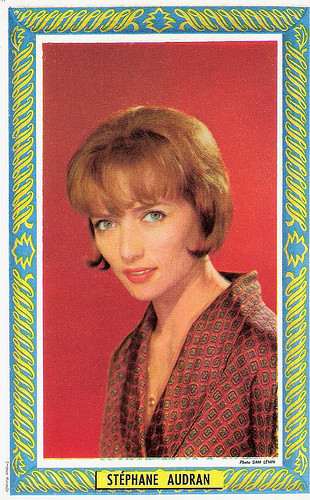
Vintage Postcard by Ste. Anne, Marseille. Photo: Sam Lévin.
Ménage à Trois
Stéphane Audran was born as Colette Suzanne Dacheville in Versailles, in 1932.
She made her film debut in Le jeu de la nuit/The Game of the Night (Daniel Costelle, 1957). Her first major role was in Claude Chabrol's film Les Cousins/The Cousins (1959) starring Gérard Blain and Jean-Claude Brialy .
At the time she was married to actor Jean-Louis Trintignant . Audran and Chabrol started a relationship from which their son, the French actor Thomas Chabrol was born in 1963. A year later they married and she has since appeared in some 20 of Chabrol's films.
Her films with Chabrol include Les Bonnes Femmes/The Good Time Girls (1960) with Bernadette Lafont , and L'oeil du malin/The Third Lover (1962) with Jacques Charrier .
She first gained notice or her role in Les Biches (Claude Chabrol, 1968) as a rich lesbian who becomes involved in a ménage à trois. At the 18th Berlin International Film Festival, she won the Silver Bear for Best Actress for this role. The film also inaugurated a second golden era in the career of her husband - roughly 1968-1973.
The spellbinding mysterious atmosphere of such films as the crime drama La Femme Infidèle/The Unfaithful Wife (1968), the thriller Le Boucher/The Butcher (1970), the thriller La rupture/The Breach (1970), the drama Juste Avant La Nuit/Just Before Nightfall (1971) and the crime drama Les noces rouges/Wedding in Blood (1973) starring Michel Piccoli, owes a lot to Audran.
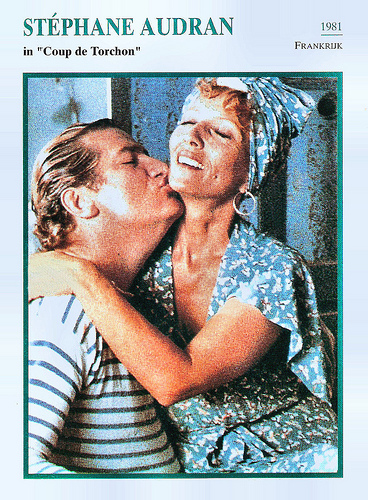
Dutch collectors card in the Filmsterren: een Portret series by Edito Service S.A., 1992. Photo: Ciné-Plus. Publicity still for Coup de Torchon (Bertrand Tavernier, 1981) with Philippe Noiret .
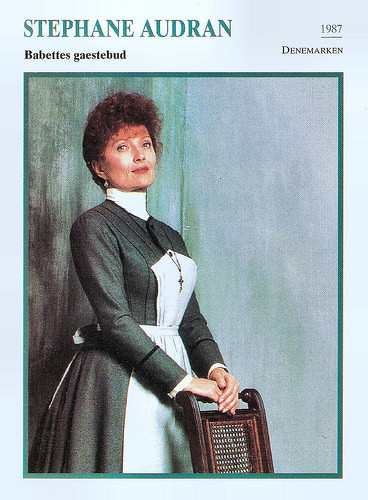
Dutch collectors card in the Filmsterren: een Portret series by Edito Service S.A., 1992. Photo: K. Lagerfeld / Stills. Publicity still for Babettes gaestebud/Babette's Feast (Gabriel Axel, 1987).
Mysterious Cook
Stéphane Audran appeared in the first film of Éric Rohmer, Signe du Lion/The Sign of Leo (1962) with Jess Hahn. She also played in La Peau de Torpedo/Children of Mata Hari (Jean Delannoy, 1970) with Klaus Kinski , Aussi loin que l'amour/As Far as Love Can Go (Frédéric Rossif, 1971) as the wife of Michel Duchaussoy, and in Orson Welles ’ The Other Side of the Wind (1972).
The most celebrated of her non-Chabrol films was Luis Buñuel's Oscar-winning satire Le charme discret de la bourgeoisie/The Discreet Charm of the Bourgeoisie (1972). In 1974, Audran won the BAFTA Film Award in Great Britain for Best Actress for her parts in Avant La Nuit/Just Before Nightfall (Claude Chabrol, 1971) and Le charme discret de la bourgeoisie/The Discreet Charm of the Bourgeoisie (1972).
In Vincent, François, Paul... et les autres/Vincent, François, Paul and the Others (Claude Sautet, 1974), she played Yves Montand ’s wife. Among her English-language productions are American features like the comedy The Black Bird (David Giler, 1975) starring George Segal, and the crime comedy Silver Bears (Ivan Passer, 1978) with Michael Caine .
Stéphane Audran won a César Award for Best Actress in a Supporting Role for her performance in Violette Nozière (Claude Chabrol, 1978) featuring Isabelle Huppert . Audran played against-type a drab, unhappy woman. Audran and Chabrol divorced in 1980.
After their divorce, Audran continued her career on full speed. She worked with cult director Samuel Fuller on his war film The Big Red One (1980) starring Lee Marvin, and his crime drama Les voleurs de la nuit/Thieves After Dark (1984) with Bobby Di Cicco.
She played the wife of a cop ( Philippe Noiret ) turned serial killer in Coup de torchon/Clean Slate (Bertrand Tavernier, 1981). Audran also appeared in international TV mini-series like Brideshead Revisited (Charles Sturridge, Michael Lindsay-Hogg, 1981) and Mistral's Daughter (Kevin Connor, Douglas Hickox, 1984).
In France she appeared in the thriller Mortelle randonnée/Deadly Circuit (Claude Miller, 1983) starring Michel Serrault and Isabelle Adjani , and in Chabrol’s Le sang des autres/The Blood of Others (Claude Chabrol, 1984) starring Jodie Foster.
After some less interesting films, she made a splash as the mysterious cook, Babette in Babettes gæstebud/Babette's Feast (Gabriel Axel, 1987) based on the novel by Karen Blixen. She continued to appear in Claude Chabrol’s films such as in Betty (1992) with Marie Trintignant, and also worked in other international films and TV series. But her later work is not as remarkable as her films of the 1960s and 1970s.
Her final film was the comedy-drama La fille de Monaco/The Girl from Monaco (Anne Fontaine, 2008) with Fabrice Luchini. Her son Thomas told the AFP news agency that his mother had died early on 27 March 2018, following a long illness. Stéphane Audran was 85.
Scene from La Femme Infidèle (1968). Source: Seidrik (YouTube).
Trailer Babette's Feast (1987). Source: Movieclips Trailer Vault (YouTube).
Sources: Allocine (French), AllMovie, Wikipedia and .

Vintage Postcard by Ste. Anne, Marseille. Photo: Sam Lévin.
Ménage à Trois
Stéphane Audran was born as Colette Suzanne Dacheville in Versailles, in 1932.
She made her film debut in Le jeu de la nuit/The Game of the Night (Daniel Costelle, 1957). Her first major role was in Claude Chabrol's film Les Cousins/The Cousins (1959) starring Gérard Blain and Jean-Claude Brialy .
At the time she was married to actor Jean-Louis Trintignant . Audran and Chabrol started a relationship from which their son, the French actor Thomas Chabrol was born in 1963. A year later they married and she has since appeared in some 20 of Chabrol's films.
Her films with Chabrol include Les Bonnes Femmes/The Good Time Girls (1960) with Bernadette Lafont , and L'oeil du malin/The Third Lover (1962) with Jacques Charrier .
She first gained notice or her role in Les Biches (Claude Chabrol, 1968) as a rich lesbian who becomes involved in a ménage à trois. At the 18th Berlin International Film Festival, she won the Silver Bear for Best Actress for this role. The film also inaugurated a second golden era in the career of her husband - roughly 1968-1973.
The spellbinding mysterious atmosphere of such films as the crime drama La Femme Infidèle/The Unfaithful Wife (1968), the thriller Le Boucher/The Butcher (1970), the thriller La rupture/The Breach (1970), the drama Juste Avant La Nuit/Just Before Nightfall (1971) and the crime drama Les noces rouges/Wedding in Blood (1973) starring Michel Piccoli, owes a lot to Audran.

Dutch collectors card in the Filmsterren: een Portret series by Edito Service S.A., 1992. Photo: Ciné-Plus. Publicity still for Coup de Torchon (Bertrand Tavernier, 1981) with Philippe Noiret .

Dutch collectors card in the Filmsterren: een Portret series by Edito Service S.A., 1992. Photo: K. Lagerfeld / Stills. Publicity still for Babettes gaestebud/Babette's Feast (Gabriel Axel, 1987).
Mysterious Cook
Stéphane Audran appeared in the first film of Éric Rohmer, Signe du Lion/The Sign of Leo (1962) with Jess Hahn. She also played in La Peau de Torpedo/Children of Mata Hari (Jean Delannoy, 1970) with Klaus Kinski , Aussi loin que l'amour/As Far as Love Can Go (Frédéric Rossif, 1971) as the wife of Michel Duchaussoy, and in Orson Welles ’ The Other Side of the Wind (1972).
The most celebrated of her non-Chabrol films was Luis Buñuel's Oscar-winning satire Le charme discret de la bourgeoisie/The Discreet Charm of the Bourgeoisie (1972). In 1974, Audran won the BAFTA Film Award in Great Britain for Best Actress for her parts in Avant La Nuit/Just Before Nightfall (Claude Chabrol, 1971) and Le charme discret de la bourgeoisie/The Discreet Charm of the Bourgeoisie (1972).
In Vincent, François, Paul... et les autres/Vincent, François, Paul and the Others (Claude Sautet, 1974), she played Yves Montand ’s wife. Among her English-language productions are American features like the comedy The Black Bird (David Giler, 1975) starring George Segal, and the crime comedy Silver Bears (Ivan Passer, 1978) with Michael Caine .
Stéphane Audran won a César Award for Best Actress in a Supporting Role for her performance in Violette Nozière (Claude Chabrol, 1978) featuring Isabelle Huppert . Audran played against-type a drab, unhappy woman. Audran and Chabrol divorced in 1980.
After their divorce, Audran continued her career on full speed. She worked with cult director Samuel Fuller on his war film The Big Red One (1980) starring Lee Marvin, and his crime drama Les voleurs de la nuit/Thieves After Dark (1984) with Bobby Di Cicco.
She played the wife of a cop ( Philippe Noiret ) turned serial killer in Coup de torchon/Clean Slate (Bertrand Tavernier, 1981). Audran also appeared in international TV mini-series like Brideshead Revisited (Charles Sturridge, Michael Lindsay-Hogg, 1981) and Mistral's Daughter (Kevin Connor, Douglas Hickox, 1984).
In France she appeared in the thriller Mortelle randonnée/Deadly Circuit (Claude Miller, 1983) starring Michel Serrault and Isabelle Adjani , and in Chabrol’s Le sang des autres/The Blood of Others (Claude Chabrol, 1984) starring Jodie Foster.
After some less interesting films, she made a splash as the mysterious cook, Babette in Babettes gæstebud/Babette's Feast (Gabriel Axel, 1987) based on the novel by Karen Blixen. She continued to appear in Claude Chabrol’s films such as in Betty (1992) with Marie Trintignant, and also worked in other international films and TV series. But her later work is not as remarkable as her films of the 1960s and 1970s.
Her final film was the comedy-drama La fille de Monaco/The Girl from Monaco (Anne Fontaine, 2008) with Fabrice Luchini. Her son Thomas told the AFP news agency that his mother had died early on 27 March 2018, following a long illness. Stéphane Audran was 85.
Scene from La Femme Infidèle (1968). Source: Seidrik (YouTube).
Trailer Babette's Feast (1987). Source: Movieclips Trailer Vault (YouTube).
Sources: Allocine (French), AllMovie, Wikipedia and .
Published on March 28, 2018 22:00
Stéphane Audran
On 27 March 2018, French film and television actress Stéphane Audran (1932-2018) passed away. The cool and aristocratic looking star was known for her performances in Oscar winning films such as Le charme discret de la bourgeoisie (1972) and Babettes gæstebud/ Babette's Feast (1987). She appeared in many films by director and screenwriter Claude Chabrol, who was her husband for 16 years.

Vintage Postcard by Ste. Anne, Marseille. Photo: Sam Lévin.
Ménage à Trois
Stéphane Audran was born as Colette Suzanne Dacheville in Versailles, in 1932.
She made her film debut in Le jeu de la nuit/The Game of the Night (Daniel Costelle, 1957). Her first major role was in Claude Chabrol's film Les Cousins/The Cousins (1959) starring Gérard Blain and Jean-Claude Brialy .
At the time she was married to actor Jean-Louis Trintignant . Audran and Chabrol started a relationship from which their son, the French actor Thomas Chabrol was born in 1963. A year later they married and she has since appeared in some 20 of Chabrol's films.
Her films with Chabrol include Les Bonnes Femmes/The Good Time Girls (1960) with Bernadette Lafont , and L'oeil du malin/The Third Lover (1962) with Jacques Charrier .
She first gained notice or her role in Les Biches (Claude Chabrol, 1968) as a rich lesbian who becomes involved in a ménage à trois. At the 18th Berlin International Film Festival, she won the Silver Bear for Best Actress for this role. The film also inaugurated a second golden era in the career of her husband - roughly 1968-1973.
The spellbinding mysterious atmosphere of such films as the crime drama La Femme Infidèle/The Unfaithful Wife (1968), the thriller Le Boucher/The Butcher (1970), the thriller La rupture/The Breach (1970), the drama Juste Avant La Nuit/Just Before Nightfall (1971) and the crime drama Les noces rouges/Wedding in Blood (1973) starring Michel Piccoli, owes a lot to Audran.

Dutch collectors card in the Filmsterren: een Portret series by Edito Service S.A., 1992. Photo: Ciné-Plus. Publicity still for Coup de Torchon (Bertrand Tavernier, 1981) with Philippe Noiret .

Dutch collectors card in the Filmsterren: een Portret series by Edito Service S.A., 1992. Photo: K. Lagerfeld / Stills. Publicity still for Babettes gaestebud/Babette's Feast (Gabriel Axel, 1987).
Mysterious Cook
Stéphane Audran appeared in the first film of Éric Rohmer, Signe du Lion/The Sign of Leo (1962) with Jess Hahn. She also played in La Peau de Torpedo/Children of Mata Hari (Jean Delannoy, 1970) with Klaus Kinski , Aussi loin que l'amour/As Far as Love Can Go (Frédéric Rossif, 1971) as the wife of Michel Duchaussoy, and in Orson Welles ’ The Other Side of the Wind (1972).
The most celebrated of her non-Chabrol films was Luis Buñuel's Oscar-winning satire Le charme discret de la bourgeoisie/The Discreet Charm of the Bourgeoisie (1972). In 1974, Audran won the BAFTA Film Award in Great Britain for Best Actress for her parts in Avant La Nuit/Just Before Nightfall (Claude Chabrol, 1971) and Le charme discret de la bourgeoisie/The Discreet Charm of the Bourgeoisie (1972).
In Vincent, François, Paul... et les autres/Vincent, François, Paul and the Others (Claude Sautet, 1974), she played Yves Montand ’s wife. Among her English-language productions are American features like the comedy The Black Bird (David Giler, 1975) starring George Segal, and the crime comedy Silver Bears (Ivan Passer, 1978) with Michael Caine .
Stéphane Audran won a César Award for Best Actress in a Supporting Role for her performance in Violette Nozière (Claude Chabrol, 1978) featuring Isabelle Huppert . Audran played against-type a drab, unhappy woman. Audran and Chabrol divorced in 1980.
After their divorce, Audran continued her career on full speed. She worked with cult director Samuel Fuller on his war film The Big Red One (1980) starring Lee Marvin, and his crime drama Les voleurs de la nuit/Thieves After Dark (1984) with Bobby Di Cicco.
She played the wife of a cop ( Philippe Noiret ) turned serial killer in Coup de torchon/Clean Slate (Bertrand Tavernier, 1981). Audran also appeared in international TV mini-series like Brideshead Revisited (Charles Sturridge, Michael Lindsay-Hogg, 1981) and Mistral's Daughter (Kevin Connor, Douglas Hickox, 1984).
In France she appeared in the thriller Mortelle randonnée/Deadly Circuit (Claude Miller, 1983) starring Michel Serrault and Isabelle Adjani , and in Chabrol’s Le sang des autres/The Blood of Others (Claude Chabrol, 1984) starring Jodie Foster.
After some less interesting films, she made a splash as the mysterious cook, Babette in Babettes gæstebud/Babette's Feast (Gabriel Axel, 1987) based on the novel by Karen Blixen. She continued to appear in Claude Chabrol’s films such as in Betty (1992) with Marie Trintignant, and also worked in other international films and TV series. But her later work is not as remarkable as her films of the 1960s and 1970s.
Her final film was the comedy-drama La fille de Monaco/The Girl from Monaco (Anne Fontaine, 2008) with Fabrice Luchini. Her son Thomas told the AFP news agency that his mother had died early on 27 March 2018, following a long illness. Stéphane Audran was 85.
Scene from La Femme Infidèle (1968). Source: Seidrik (YouTube).
Trailer Babette's Feast (1987). Source: Movieclips Trailer Vault (YouTube).
Sources: Allocine (French), AllMovie, Wikipedia and .

Vintage Postcard by Ste. Anne, Marseille. Photo: Sam Lévin.
Ménage à Trois
Stéphane Audran was born as Colette Suzanne Dacheville in Versailles, in 1932.
She made her film debut in Le jeu de la nuit/The Game of the Night (Daniel Costelle, 1957). Her first major role was in Claude Chabrol's film Les Cousins/The Cousins (1959) starring Gérard Blain and Jean-Claude Brialy .
At the time she was married to actor Jean-Louis Trintignant . Audran and Chabrol started a relationship from which their son, the French actor Thomas Chabrol was born in 1963. A year later they married and she has since appeared in some 20 of Chabrol's films.
Her films with Chabrol include Les Bonnes Femmes/The Good Time Girls (1960) with Bernadette Lafont , and L'oeil du malin/The Third Lover (1962) with Jacques Charrier .
She first gained notice or her role in Les Biches (Claude Chabrol, 1968) as a rich lesbian who becomes involved in a ménage à trois. At the 18th Berlin International Film Festival, she won the Silver Bear for Best Actress for this role. The film also inaugurated a second golden era in the career of her husband - roughly 1968-1973.
The spellbinding mysterious atmosphere of such films as the crime drama La Femme Infidèle/The Unfaithful Wife (1968), the thriller Le Boucher/The Butcher (1970), the thriller La rupture/The Breach (1970), the drama Juste Avant La Nuit/Just Before Nightfall (1971) and the crime drama Les noces rouges/Wedding in Blood (1973) starring Michel Piccoli, owes a lot to Audran.

Dutch collectors card in the Filmsterren: een Portret series by Edito Service S.A., 1992. Photo: Ciné-Plus. Publicity still for Coup de Torchon (Bertrand Tavernier, 1981) with Philippe Noiret .

Dutch collectors card in the Filmsterren: een Portret series by Edito Service S.A., 1992. Photo: K. Lagerfeld / Stills. Publicity still for Babettes gaestebud/Babette's Feast (Gabriel Axel, 1987).
Mysterious Cook
Stéphane Audran appeared in the first film of Éric Rohmer, Signe du Lion/The Sign of Leo (1962) with Jess Hahn. She also played in La Peau de Torpedo/Children of Mata Hari (Jean Delannoy, 1970) with Klaus Kinski , Aussi loin que l'amour/As Far as Love Can Go (Frédéric Rossif, 1971) as the wife of Michel Duchaussoy, and in Orson Welles ’ The Other Side of the Wind (1972).
The most celebrated of her non-Chabrol films was Luis Buñuel's Oscar-winning satire Le charme discret de la bourgeoisie/The Discreet Charm of the Bourgeoisie (1972). In 1974, Audran won the BAFTA Film Award in Great Britain for Best Actress for her parts in Avant La Nuit/Just Before Nightfall (Claude Chabrol, 1971) and Le charme discret de la bourgeoisie/The Discreet Charm of the Bourgeoisie (1972).
In Vincent, François, Paul... et les autres/Vincent, François, Paul and the Others (Claude Sautet, 1974), she played Yves Montand ’s wife. Among her English-language productions are American features like the comedy The Black Bird (David Giler, 1975) starring George Segal, and the crime comedy Silver Bears (Ivan Passer, 1978) with Michael Caine .
Stéphane Audran won a César Award for Best Actress in a Supporting Role for her performance in Violette Nozière (Claude Chabrol, 1978) featuring Isabelle Huppert . Audran played against-type a drab, unhappy woman. Audran and Chabrol divorced in 1980.
After their divorce, Audran continued her career on full speed. She worked with cult director Samuel Fuller on his war film The Big Red One (1980) starring Lee Marvin, and his crime drama Les voleurs de la nuit/Thieves After Dark (1984) with Bobby Di Cicco.
She played the wife of a cop ( Philippe Noiret ) turned serial killer in Coup de torchon/Clean Slate (Bertrand Tavernier, 1981). Audran also appeared in international TV mini-series like Brideshead Revisited (Charles Sturridge, Michael Lindsay-Hogg, 1981) and Mistral's Daughter (Kevin Connor, Douglas Hickox, 1984).
In France she appeared in the thriller Mortelle randonnée/Deadly Circuit (Claude Miller, 1983) starring Michel Serrault and Isabelle Adjani , and in Chabrol’s Le sang des autres/The Blood of Others (Claude Chabrol, 1984) starring Jodie Foster.
After some less interesting films, she made a splash as the mysterious cook, Babette in Babettes gæstebud/Babette's Feast (Gabriel Axel, 1987) based on the novel by Karen Blixen. She continued to appear in Claude Chabrol’s films such as in Betty (1992) with Marie Trintignant, and also worked in other international films and TV series. But her later work is not as remarkable as her films of the 1960s and 1970s.
Her final film was the comedy-drama La fille de Monaco/The Girl from Monaco (Anne Fontaine, 2008) with Fabrice Luchini. Her son Thomas told the AFP news agency that his mother had died early on 27 March 2018, following a long illness. Stéphane Audran was 85.
Scene from La Femme Infidèle (1968). Source: Seidrik (YouTube).
Trailer Babette's Feast (1987). Source: Movieclips Trailer Vault (YouTube).
Sources: Allocine (French), AllMovie, Wikipedia and .
Published on March 28, 2018 22:00
March 27, 2018
Halkas Gelöbnis (1918)
Lya Mara was the star in the German silent melodrama Halkas Gelöbnis/Halka's Vow (1918). Her co-star was the young Hans Albers, in his first film role. Alfred Halm directed the film under his regular pseudonym H. Fredall, while he also scripted the film. The postcards were published by the Berlin firm Photochemie.
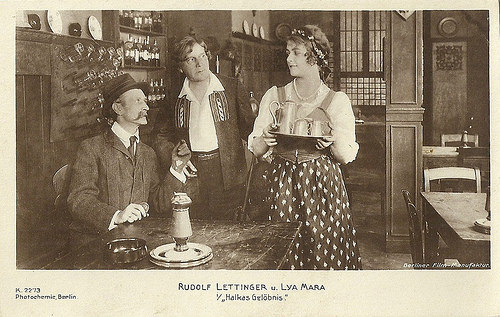
German postcard by Photochemie, Berlin, no. K. 2273. Photo: Berliner Film-Manufaktur. Rudolf Lettinger (?) and Lya Mara in Halkas Gelöbnis (H. Fredall, 1918).
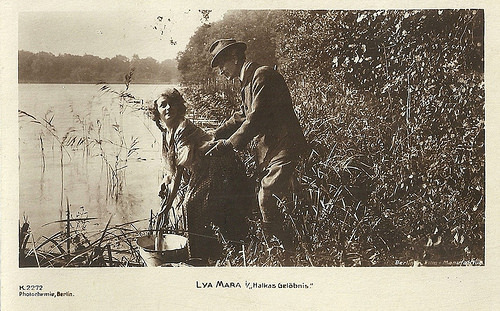
German postcard by Photochemie, Berlin, no. K. 2272. Photo: Berliner Film-Manufaktur. Lya Mara in Halkas Gelöbnis (H. Fredall, 1918).
Eternal loyalty
Before she was a big star as comedienne in the 1920s, Lya Mara did various dramatic films in the 1910s. An example is Halkas Gelöbnis, which was shot in the Autumn of 1917 and premiered in January 1918.
Producer of the film was Mara's future husband, Friedrich Zelnik later known as Frederic Zelnik.
Halkas Gelöbnis is situated somewhere and somewhen in Poland. Count Symon Barinowsky ( Hans Albers ) returns to his homestead and falls in love with his foster sister Halka ( Lya Mara ).
His mother instead wants Symon to marry aristocracy, but before the statue of the Holy Virgin, Halka promises eternal loyalty to Symon. When Symon is away in Java, the countess notices Halka is courted by Dr. Piorkowsky ( Erich Kaiser-Titz ) and announces their engagement.
Halka, devastated, writes Symon about his mother's plans and swears eternal loyalty to Symon. Even in her wedding night with the doctor, Halka remains true to Symon.
That night Symon returns and the two men fight, until the old servant Jan (Rudolf Lettinger) comes between them and explains Halka is Symon's half-sister. Halka overhears this and collapses.
Her husband takes care of her. Afterwards Halka's oath to Symon turns into another one, of eternal friendship.
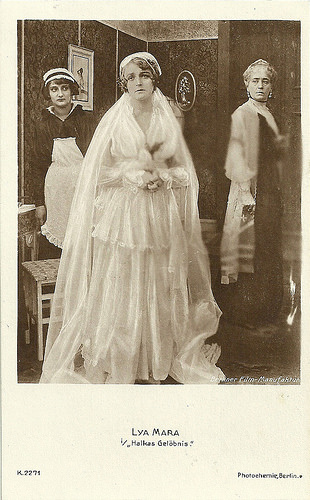
German postcard by Photochemie, Berlin, no. K. 2271. Photo: Berliner Film-Manufaktur. Lya Mara in Halkas Gelöbnis (H. Fredall, 1918).
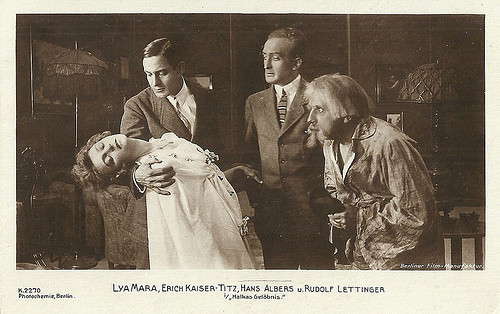
German postcard by Photochemie, Berlin, no. K. 2270. Photo: Berliner Film-Manufaktur. Lya Mara , Erich Kaiser-Titz , Hans Albers and Rudolf Lettinger in Halkas Gelöbnis (H. Fredall, 1918).
Sources: Wikiwand and IMDb.

German postcard by Photochemie, Berlin, no. K. 2273. Photo: Berliner Film-Manufaktur. Rudolf Lettinger (?) and Lya Mara in Halkas Gelöbnis (H. Fredall, 1918).

German postcard by Photochemie, Berlin, no. K. 2272. Photo: Berliner Film-Manufaktur. Lya Mara in Halkas Gelöbnis (H. Fredall, 1918).
Eternal loyalty
Before she was a big star as comedienne in the 1920s, Lya Mara did various dramatic films in the 1910s. An example is Halkas Gelöbnis, which was shot in the Autumn of 1917 and premiered in January 1918.
Producer of the film was Mara's future husband, Friedrich Zelnik later known as Frederic Zelnik.
Halkas Gelöbnis is situated somewhere and somewhen in Poland. Count Symon Barinowsky ( Hans Albers ) returns to his homestead and falls in love with his foster sister Halka ( Lya Mara ).
His mother instead wants Symon to marry aristocracy, but before the statue of the Holy Virgin, Halka promises eternal loyalty to Symon. When Symon is away in Java, the countess notices Halka is courted by Dr. Piorkowsky ( Erich Kaiser-Titz ) and announces their engagement.
Halka, devastated, writes Symon about his mother's plans and swears eternal loyalty to Symon. Even in her wedding night with the doctor, Halka remains true to Symon.
That night Symon returns and the two men fight, until the old servant Jan (Rudolf Lettinger) comes between them and explains Halka is Symon's half-sister. Halka overhears this and collapses.
Her husband takes care of her. Afterwards Halka's oath to Symon turns into another one, of eternal friendship.

German postcard by Photochemie, Berlin, no. K. 2271. Photo: Berliner Film-Manufaktur. Lya Mara in Halkas Gelöbnis (H. Fredall, 1918).

German postcard by Photochemie, Berlin, no. K. 2270. Photo: Berliner Film-Manufaktur. Lya Mara , Erich Kaiser-Titz , Hans Albers and Rudolf Lettinger in Halkas Gelöbnis (H. Fredall, 1918).
Sources: Wikiwand and IMDb.
Published on March 27, 2018 22:00
March 26, 2018
Anita Dorris
Beautiful German leading lady Anita Dorris (1903-1993) started as a stage actress in 1921, after which some 15 silent films followed. Dorris was beloved in the late 1920s and smoothly made the passage to sound. In 1930, she married Austrian film director E. W. Emo and withdrew from the cinema. Her daughter, Maria Emo, would also become a well known stage and film actress.
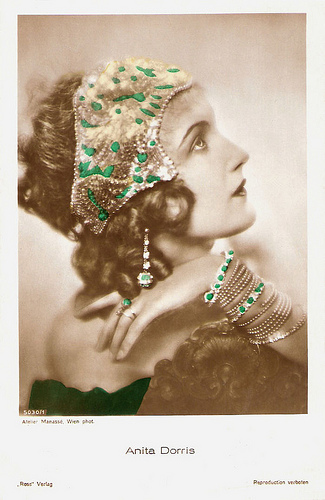
German postcard by Ross Verlag, no. 5030/1, 1930-1931. Photo: Atelier Manassé, Vienna.
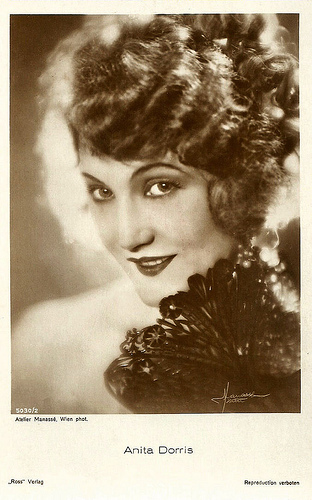
German postcard by Ross Verlag, no. 5030/2, 1930-1931. Photo: Atelier Manassé, Vienna.
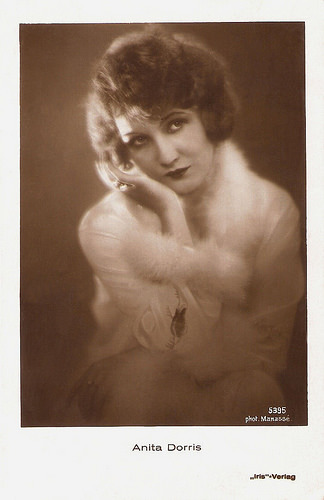
Austrian postcard by Iris-Verlag, no. 5395. Photo: Atelier Manassé.
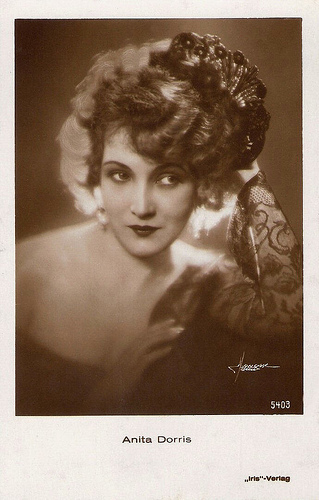
Austrian postcard by Iris Verlag, no. 5403. Photo: Atelier Manassé, Wien.
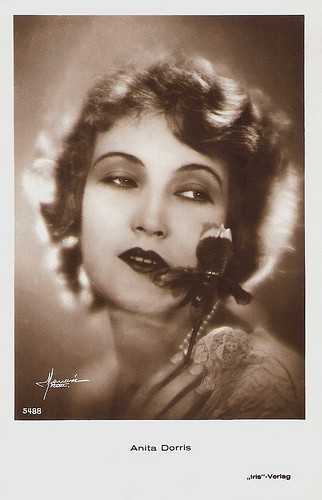
Austrian postcard by Iris-Verlag, no. 5488. Photo: Atelier Manassé.
Film actress by accident
Anita Dorris was born Anita Dorothea Schmidt in 1903 in Lübeck, Germany. She was the daughter of Ernst Schmidt, the owner of a printing company.
In 1921, because of her acquaintance with Anton Kohl, Anita got her first engagement as a stage actress at the Stadttheater Eger. She moved on to theatres in the cities of Pilsen and Franzensbad, and from 1923 till 1925 she worked in Prague.
Her film career started by accident. She acted for a friendly cameraman who wanted to apply for a job with director Friedrich Zelnik (aka Frederic Zelnik) with a sample of his skill. However, Zelnik didn't pay attention to the work of the cameraman but was enthusiastic about the acting by Schmidt.
He engaged her for his film Die Mühle von Sanssouci/The Mill of Sanssouci (Siegfried Philippi, Friedrich Zelnik, 1926), and Anita Schmidt changed her name into Anita Dorris. In her film debut she appeared with the stars Otto Gebühr and Olga Tschechova , and soon some 15 more silent films followed.
She worked on three films with Dutch director Jaap Speyer: Liebeshandel/Love Affair (1927), Bigamie/Bigamy (1927) and Die Sache mit Schorrsiegel/The Schorsiegel Case (1928).
According to Thomas Staedeli at Cyranos , her most impressive performance was Trilby in the drama Svengali (Gennaro Righelli, 1927) opposite Paul Wegener in the title role.
Dorris also played Friederike of Prussia in both Die Jugend der Königin Luise/Königin Luise I/Queen Louise and Königin Luise II (Karl Grune, 1927), based on screenplays by Ludwig Berger.
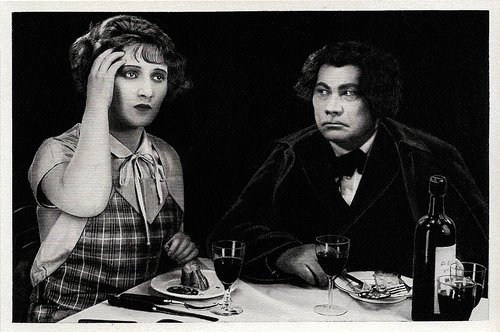
German collectors card by Ross Verlag in the series Vom Werden Deutscher Filmkunst - Der Stumme Film, picture no. 135, group 43. Photo: Terra Film. Publicity still for Svengali (Gennaro Righelli, 1927) with Paul Wegener .
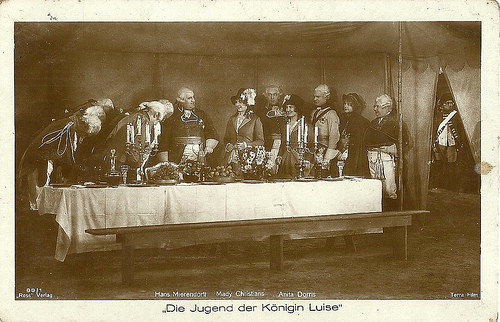
German postcard by Ross Verlag, no. 88/1. Photo: Terra Film. Mady Christians, Anita Dorris and Hans Mierendorff in Die Jugend der Königin Luise/Königin Luise I (Karl Grüne, 1927).
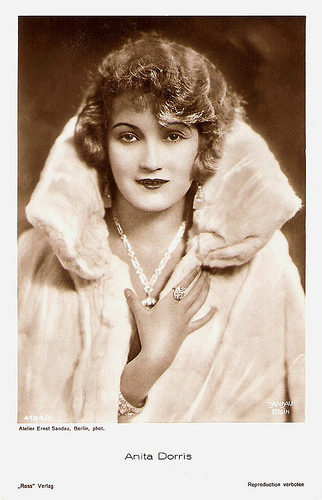
German postcard by Ross Verlag, no. 4194/1, 1929-1930. Photo: Atelier Ernst Sandau, Berlin.
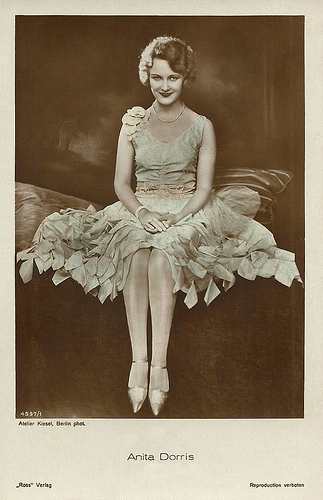
German postcard by Ross Verlag, no. 4597/1, 1929-1930. Photo: Atelier Kiesel, Berlin. Collection: Didier Hanson.
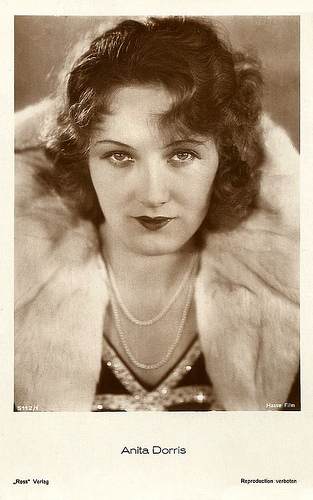
German postcard by Ross Verlag, no. 5112/1, 1930-1931. Photo: Hasse Film.
The first German sound film
Anita Dorris was beloved in the late silent film era and with her stage-trained voice, she smoothly made the passage to sound film.
In 1929, she appeared in the first German sound film, the short Mein Traum wär ein Mädel/My Dream Was a Girl (E.W. Emo, 1929) with Rudolf Platte .
She also costarred in the prestigious German-Swedish coproduction Mach die Welt ein Paradies/Make the World a Paradise for me (Paul Merzbach, 1930), opposite Swedish actor Gösta Ekman , the star from F.W. Murnau's Faust.
That same year 1930, however, her promising film career came abrupt to an end. She married film director E.W. Emo and she retired from the cinema at his request.
Her final film was Student sein, wenn die Veilchen blühen/Student Life in Marry Springtime (Heinz Paul, 1931) with Fred Louis Lerch .
Ever since 1939, Anita Dorris lived in Vienna, where she died in 1993. Her daughter, Maria Emo (1936), would become a well known stage and film actress in the 1950s.
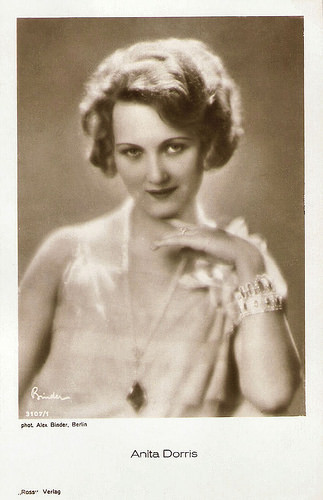
German postcard by Ross Verlag, no. 3107/1, 1928-1929. Photo: Alex Binder, Berlin.
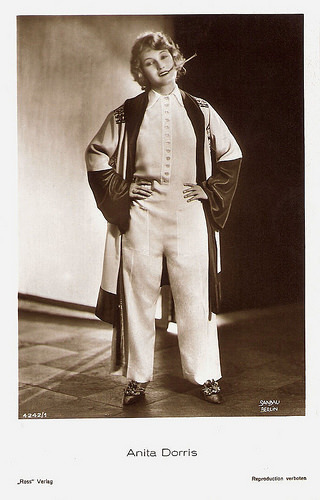
German postcard by Ross Verlag, no. 4242/1, 1929-1930. Photo: Sandau, Berlin.
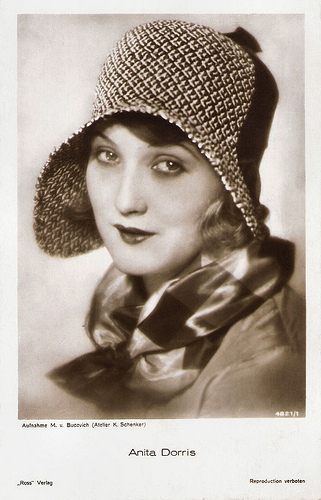
German postcard by Ross Verlag, no. 4821/1, 1929-1930. Photo: M. von Bucovich (Atelier K. Schenker).
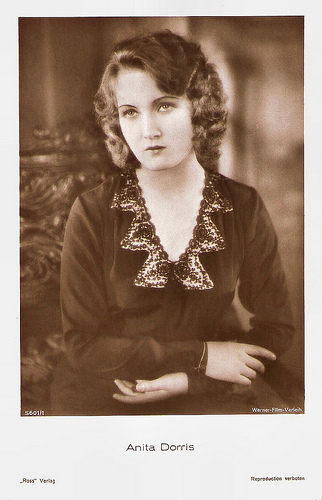
German postcard by Ross Verlag, no. 5601/1, 1930-1931. Photo: Werner-Film-Verleih.
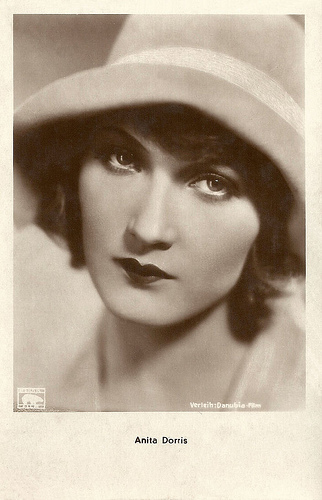
Austrian postcard by Iris Verlag, no. 6031. Photo: Bear Film. Distr. / Danubio-Film.
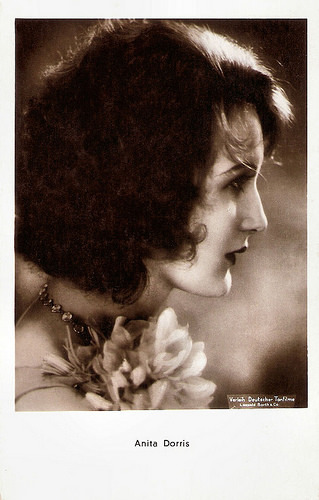
Austrian postcard by Iris-Verlag, no. 6142. Photo: Verleih Deutsche Tonfilme Leopold Barth & Co.
Sources: Thomas Staedeli (Cyranos), Wikipedia (German), and .

German postcard by Ross Verlag, no. 5030/1, 1930-1931. Photo: Atelier Manassé, Vienna.

German postcard by Ross Verlag, no. 5030/2, 1930-1931. Photo: Atelier Manassé, Vienna.

Austrian postcard by Iris-Verlag, no. 5395. Photo: Atelier Manassé.

Austrian postcard by Iris Verlag, no. 5403. Photo: Atelier Manassé, Wien.

Austrian postcard by Iris-Verlag, no. 5488. Photo: Atelier Manassé.
Film actress by accident
Anita Dorris was born Anita Dorothea Schmidt in 1903 in Lübeck, Germany. She was the daughter of Ernst Schmidt, the owner of a printing company.
In 1921, because of her acquaintance with Anton Kohl, Anita got her first engagement as a stage actress at the Stadttheater Eger. She moved on to theatres in the cities of Pilsen and Franzensbad, and from 1923 till 1925 she worked in Prague.
Her film career started by accident. She acted for a friendly cameraman who wanted to apply for a job with director Friedrich Zelnik (aka Frederic Zelnik) with a sample of his skill. However, Zelnik didn't pay attention to the work of the cameraman but was enthusiastic about the acting by Schmidt.
He engaged her for his film Die Mühle von Sanssouci/The Mill of Sanssouci (Siegfried Philippi, Friedrich Zelnik, 1926), and Anita Schmidt changed her name into Anita Dorris. In her film debut she appeared with the stars Otto Gebühr and Olga Tschechova , and soon some 15 more silent films followed.
She worked on three films with Dutch director Jaap Speyer: Liebeshandel/Love Affair (1927), Bigamie/Bigamy (1927) and Die Sache mit Schorrsiegel/The Schorsiegel Case (1928).
According to Thomas Staedeli at Cyranos , her most impressive performance was Trilby in the drama Svengali (Gennaro Righelli, 1927) opposite Paul Wegener in the title role.
Dorris also played Friederike of Prussia in both Die Jugend der Königin Luise/Königin Luise I/Queen Louise and Königin Luise II (Karl Grune, 1927), based on screenplays by Ludwig Berger.

German collectors card by Ross Verlag in the series Vom Werden Deutscher Filmkunst - Der Stumme Film, picture no. 135, group 43. Photo: Terra Film. Publicity still for Svengali (Gennaro Righelli, 1927) with Paul Wegener .

German postcard by Ross Verlag, no. 88/1. Photo: Terra Film. Mady Christians, Anita Dorris and Hans Mierendorff in Die Jugend der Königin Luise/Königin Luise I (Karl Grüne, 1927).

German postcard by Ross Verlag, no. 4194/1, 1929-1930. Photo: Atelier Ernst Sandau, Berlin.

German postcard by Ross Verlag, no. 4597/1, 1929-1930. Photo: Atelier Kiesel, Berlin. Collection: Didier Hanson.

German postcard by Ross Verlag, no. 5112/1, 1930-1931. Photo: Hasse Film.
The first German sound film
Anita Dorris was beloved in the late silent film era and with her stage-trained voice, she smoothly made the passage to sound film.
In 1929, she appeared in the first German sound film, the short Mein Traum wär ein Mädel/My Dream Was a Girl (E.W. Emo, 1929) with Rudolf Platte .
She also costarred in the prestigious German-Swedish coproduction Mach die Welt ein Paradies/Make the World a Paradise for me (Paul Merzbach, 1930), opposite Swedish actor Gösta Ekman , the star from F.W. Murnau's Faust.
That same year 1930, however, her promising film career came abrupt to an end. She married film director E.W. Emo and she retired from the cinema at his request.
Her final film was Student sein, wenn die Veilchen blühen/Student Life in Marry Springtime (Heinz Paul, 1931) with Fred Louis Lerch .
Ever since 1939, Anita Dorris lived in Vienna, where she died in 1993. Her daughter, Maria Emo (1936), would become a well known stage and film actress in the 1950s.

German postcard by Ross Verlag, no. 3107/1, 1928-1929. Photo: Alex Binder, Berlin.

German postcard by Ross Verlag, no. 4242/1, 1929-1930. Photo: Sandau, Berlin.

German postcard by Ross Verlag, no. 4821/1, 1929-1930. Photo: M. von Bucovich (Atelier K. Schenker).

German postcard by Ross Verlag, no. 5601/1, 1930-1931. Photo: Werner-Film-Verleih.

Austrian postcard by Iris Verlag, no. 6031. Photo: Bear Film. Distr. / Danubio-Film.

Austrian postcard by Iris-Verlag, no. 6142. Photo: Verleih Deutsche Tonfilme Leopold Barth & Co.
Sources: Thomas Staedeli (Cyranos), Wikipedia (German), and .
Published on March 26, 2018 22:00
March 25, 2018
Ronald Colman
Elegant British actor Ronald Colman (1891-1958) was a top box office draw in Hollywood films as the archetypal English gentleman throughout the 1920s, 1930s and 1940s. ‘The man with the velvet voice’ was nominated for four Academy awards. In 1948 he finally won the Oscar for his splendid portrayal of a tormented actor in A Double Life.
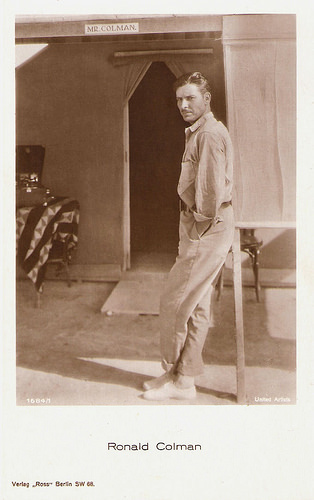
German postcard by Ross Verlag, no. 1684/1, 1927-1928. Photo: United Artists.
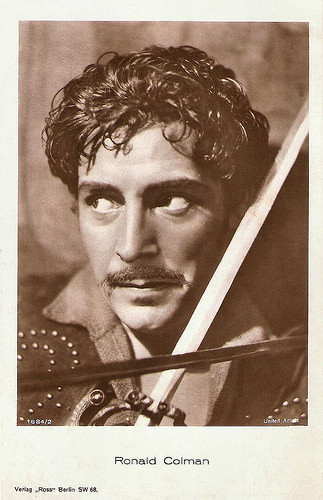
German postcard by Ross Verlag, no. 1684/2, 1927-1928. Photo: United Artists. Publicity still for Two Lovers (Fred Niblo, 1928).
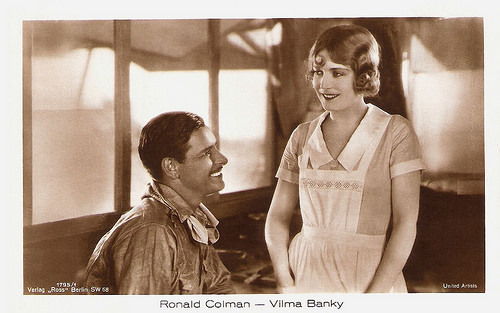
German postcard by Ross Verlag, no. 1795/1, 1927-1928. Photo: United Artists. Publicity still for The Winning of Barbara Worth (Henry King, 1926) with Vilma Bánky .
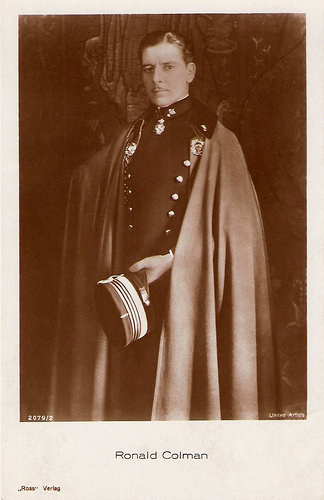
German postcard by Ross Verlag, no. 2079/2, 1927-1928. Photo: United Artists.
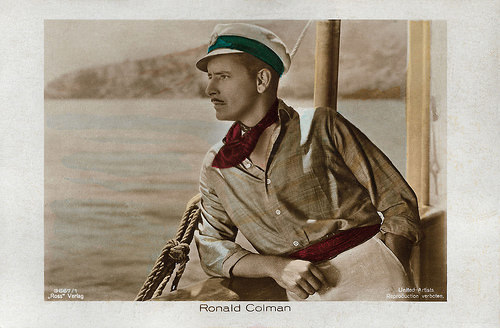
German postcard by Ross Verlag, no. 3667/1, 1928-1929. Photo: United Artists. Publicity still for The Rescue (Herbert Brenon, 1929).
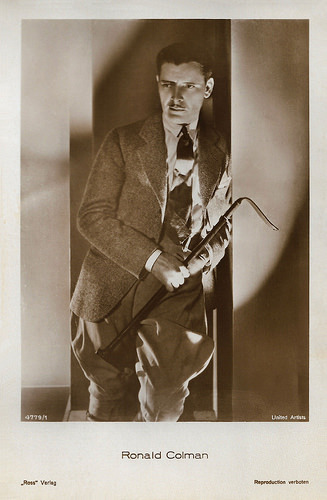
German postcard by Ross Verlag, no. 4779/1, 1929-1930. Photo: United Artists.
Decorated, discharged and depressed
Ronald Charles Colman was born in 1891 in Richmond, England. He was the fifth of six children of silk importer Charles Colman and his wife Marjory Read Fraser.
Ronald was educated at a boarding school in Littlehampton, where he discovered he enjoyed acting. When Ronald was 16 his father died by pneumonia, putting an end to the boy's plans to attend Cambridge and become an engineer. He went to work as a shipping clerk at the British Steamship Company.
He also became a well-known amateur actor, and was a member of the West Middlesex Dramatic Society (1908-1909). In 1909, he joined the London Scottish Regiment, an army territorial force, and at the outbreak of World War I he was sent to France. Colman took part in the first Battle of Ypres and was severely wounded at the battle at Messines in Belgium. The shrapnel wounds he took to his legs invalided him out of active service.
In May 1915, decorated, discharged and depressed, he returned home with a limp that he would attempt to hide throughout the rest of his acting career. He tried to enter the consular service, but a chance encounter got him a small role in the London play The Maharanee of Arakan (1916). He dropped other plans and concentrated on the theatre.
Producers soon noted the young actor with his striking good looks, rich voice and rare dignity, and Colman was rewarded with a succession of increasingly prominent parts. He worked with stage greats Gladys Cooper and Gerald du Maurier.
He made extra money appearing in films like the two-reel silent comedy The Live Wire (Cecil Hepworth, 1917). The set was an old house, the budget was negligible, and Colman doubled as the leading character and prop man. The film was never released though.
Other silent British films were The Snow of the Desert (Walter West, 1919) with Violet Hopson and Stewart Rome , and The Black Spider (William Humphrey, 1920) with Mary Clare. The negatives of all Colman's early British films have probably been destroyed during the 1941 London Blitz.
After a brief courtship, he married actress Thelma Raye in 1919. The marriage was in trouble almost from the beginning. The two separated in 1923 but were not divorced until 1934.
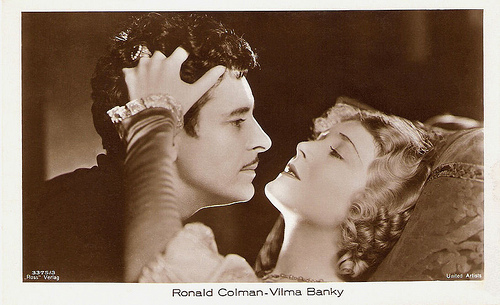
German postcard by Ross Verlag, no. 3375/3, 1928-1929. Photo: United Artists. Publicity still for Two Lovers (Fred Niblo, 1928) with Vilma Bánky .
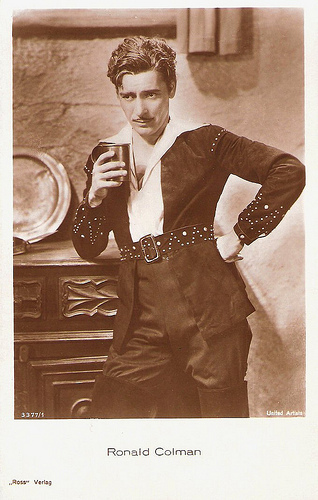
German postcard by Ross Verlag, no. 3377/1, 1928-1929. Photo: United Artists.
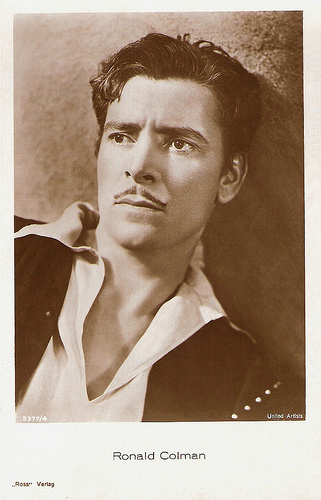
German postcard by Ross Verlag, no. 3377/4, 1928-1929. Photo: United Artists. Ronald Colman in Two Lovers (Fred Niblo 1928).
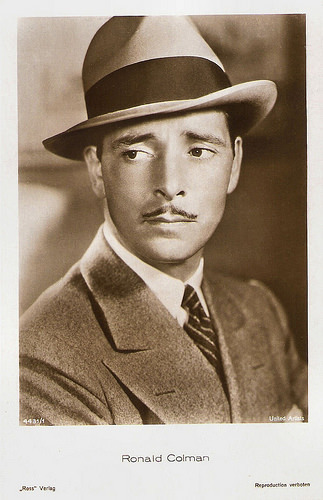
German postcard by Ross Verlag, no. 4431/1, 1929-1930. Photo: United Artists.
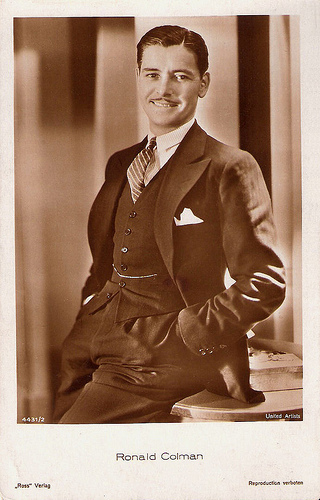
German postcard by Ross Verlag, no. 4431/2, 1929-1930. Photo: United Artists.
Romantic Tearjerker
In 1920 Ronald Colman set out for New York in hopes of finding greater fortune there than in war-depressed England. His American film debut was in the tawdry melodrama Handcuffs or Kisses? (George Archainbaud, 1920). He toured with Robert Warwick in The Dauntless Three, and subsequently toured with Fay Bainter in East is West.
After two years of impoverishment, he was cast in the Broadway hit play La Tendresse (1922). Director Henry King spotted him and cast him as Lillian Gish 's leading man in The White Sister (Henry King, 1923), filmed in Italy. The romantic tear-jerker was wildly popular and Colman was quickly proclaimed a new film star.
This success led to a contract with prominent independent film producer Samuel Goldwyn, and in the following ten years he became a very popular silent film star in both romantic and adventure films.
Among his most successful films for Goldwyn were The Dark Angel (George Fitzmaurice, 1925) with Hungarian actress Vilma Bánky , Stella Dallas (Henry King, 1926), the Oscar Wilde adaptation Lady Windermere's Fan (Ernst Lubitsch, 1925) and The Winning of Barbara Worth (Henry King, 1926) with Gary Cooper.
Colman's dark hair and eyes and his athletic and riding ability led reviewers to describe him as a ‘Valentino type’. He was often cast in similar, exotic roles. The film that cemented this position as a top star was Beau Geste (Herbert Brenon, 1926), Paramount's biggest hit of 1926.
It was the rousing tale of three brothers (Colman, Neil Hamilton and Ralph Forbes ), who join the Foreign Legion to escape the law. Beau Geste was full of mystery, desert action, intrigue and above all, brotherly loyalty. Colman's gentlemanly courage and quiet strength were showcased to perfection in the role of the oldest brother, Beau. The film is still referred to as possibly the greatest Foreign Legion film ever produced.
Towards the end of the silents era Colman was teamed again with Vilma Bánky under Samuel Goldwyn. The two would make a total of five films together and their popularity rivalled that of Greta Garbo & John Gilbert.
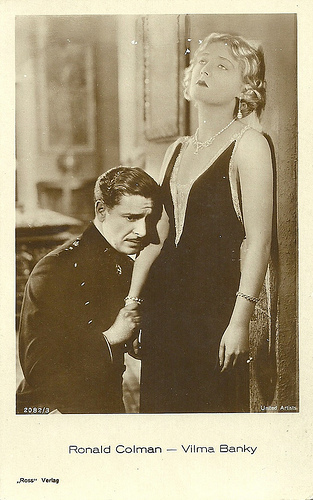
German postcard by Ross Verlag, no. 2082/3, 1927-1928. Photo: United Artists. Publicity still for The Magic Flame (Henry King 1927) with Vilma Bánky .
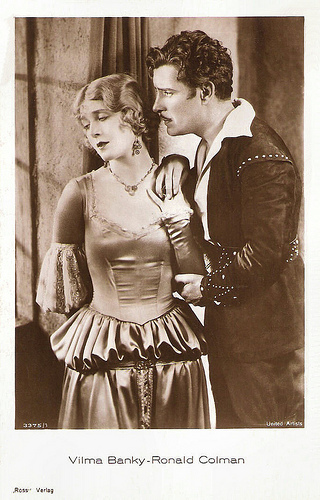
German postcard by Ross Verlag, no. 3375/1, 1928-1929. Photo: United Artists. Publicity still for Two Lovers (Fred Niblo, 1928) with Vilma Bánky .
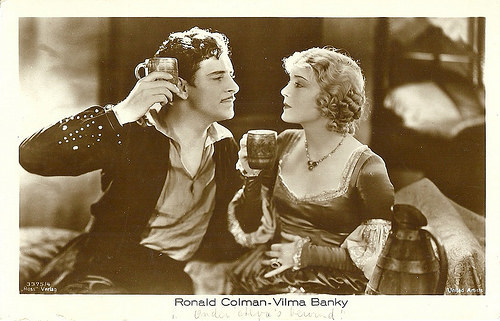
German postcard by Ross Verlag, no. 3375/4, 1928-1929. Photo: United Artists. Ronald Colman and Vilma Bánky in Two Lovers (Fred Niblo, 1928). Someone scribbled the original Dutch release title on the postcard: Onder Alva's Bewind (Under Alva's Regime).

German postcard by Ross Verlag, no. 3667/1, 1928-1929. Photo: United Artists. Publicity still for The Rescue (Herbert Brenon, 1929).
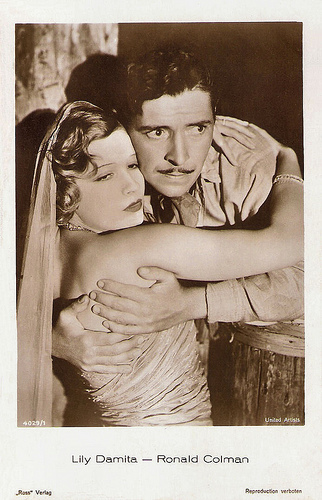
German postcard by Ross Verlag, no. 4029/1, 1929-1930. Photo: United Artists. Ronald Colman and Lily Damita in The Rescue (Herbert Brenon, 1929).
Sophisticated Thoughtful Characters of Integrity
Although Ronald Colman was a huge success in silent films, with the coming of sound, his extraordinarily beautiful speaking voice made him even more important to the film industry. His first major talkie success was in 1930, when he was nominated for the Academy Award for Best Actor for two roles - Condemned (Wesley Ruggles, 1929) with Lily Damita , and Bulldog Drummond (F. Richard Jones, 1929) with Joan Bennett.
Thereafter he played a number of sophisticated, noble characters with enormous aplomb such as Clive of India (Richard Boleslawski, 1935) with Colin Clive , but he also swashbuckled expertly when called to do so in films like The Prisoner of Zenda (John Cromwell, 1937) with Madeleine Carroll .
A falling out with Goldwyn in 1934 prompted Colman to avoid long-term contracts for the rest of his career. He became one of just a handful of top stars to successfully freelance, picking and choosing his assignments and studios.
His notable films included the Charles Dickens adaptation A Tale of Two Cities (Jack Conway, 1935), the poetic classic Lost Horizon (Frank Capra, 1937), and If I Were King (Frank Lloyd, 1938) with Basil Rathbone as vagabond poet Francois Villon.
During the war he made two of his very best films - Talk of the Town (George Stevens, 1942) with Cary Grant and Jean Arthur, and the romantic tearjerker Random Harvest (Mervyn LeRoy, 1942), as an amnesiac victim, co-starring with the luminous Greer Garson.
For his role in A Double Life (George Cukor, 1947), an actor playing Othello who comes to identify with the character, he won both the Golden Globe for Best Actor in 1947 and the Best Actor Oscar in 1948.
Colman made many guest appearances on The Jack Benny Program on the radio, alongside his second wife, British stage and screen actress Benita Hume. Their comedy work as Benny's next-door neighbours led to their own radio comedy The Halls of Ivy from 1950 to 1952, and then on television from 1954 to 1955.
Incidentally he appeared in films, such as in the romantic comedy Champagne for Caesar (Richard Whorf, 1950), and his final film The Story of Mankind (Irwin Allen, 1957) with Hedy Lamarr . Hal Erickson at AllMovie : "a laughably wretched extravaganza from which Colman managed to emerge with his dignity and reputation intact."
Ronald Colman died in 1958, aged 67, from a lung infection in Santa Barbara, California. He was survived by Benita Hume, and their daughter Juliet Benita Colman (1944). In 1975, Juliet published the biography Ronald Colman: A Very Private Person.
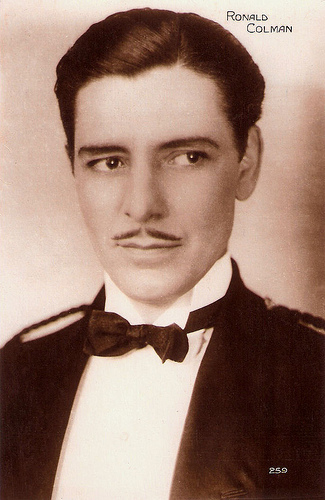
French postcard by Cinémagazine-Edition, Paris, no. 259.
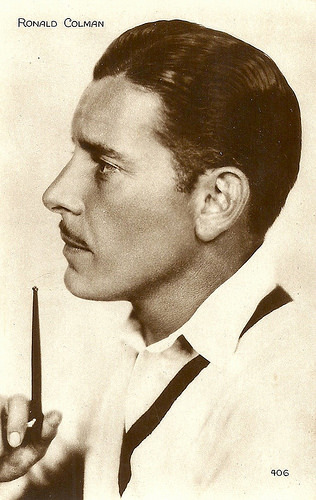
French postcard by Cinémagazine-Edition, Paris, no. 406.
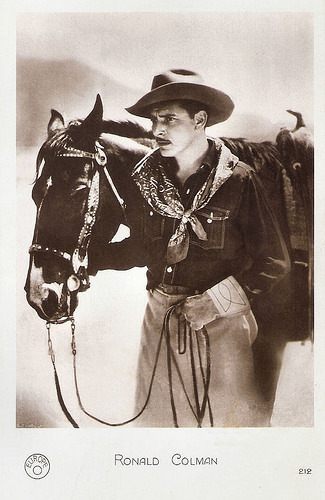
French postcard by Europe, no. 212. Photo: publicity still for The Winning of Barbara Worth (Henry King, 1926).
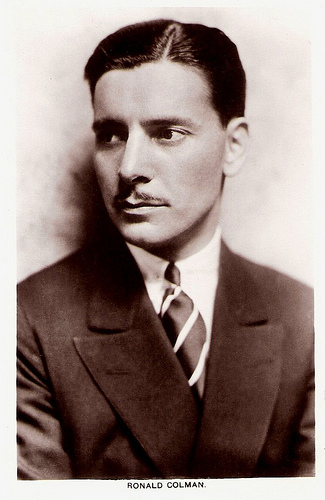
British postcard in the Picturegoer Series, London, no. 202.
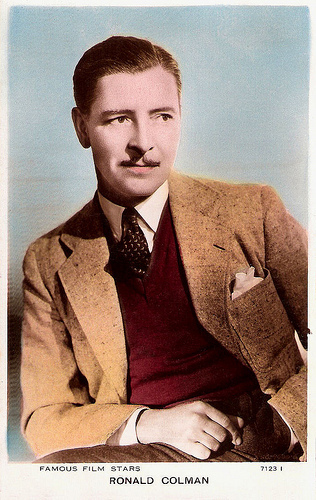
British Valentine's postcard in the Famous Film Stars Series, no. 7123 I.
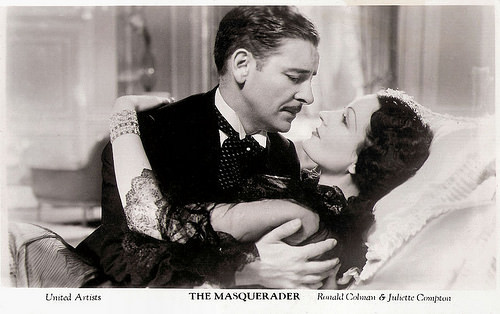
British postcard in the Filmshots series by Film Weekly. Photo: United Artists. Publicity still for The Masquerader (Richard Wallace, 1933) with Juliet Compton.
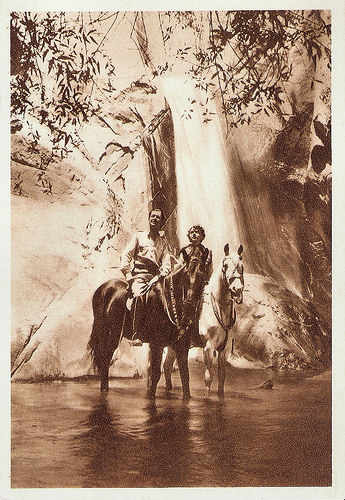
Italian postcard by Vecchioni & Guadagno, Roma. Photo: Columbia EIA. Publicity still for Lost Horizon (Frank Capra, 1937) with Jane Wyatt.
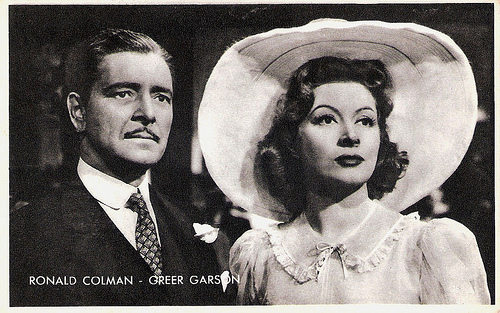
Belgian collectors card by Kwatta, Bois-D'Haine, Serie C, no. C. 170. Photo: M.G.M. Publicity still for Random Harvest (1942) with Greer Garson .
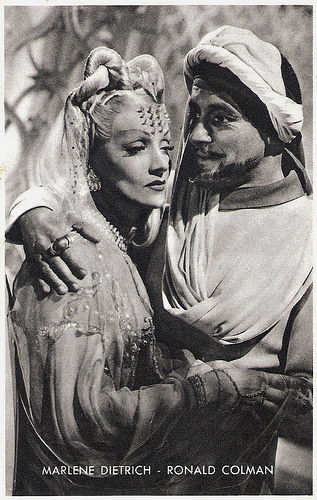
Belgian collectors card by Kwatta, Bois d'Haine, no. C 156. Photo: M.G.M. Publicity still for Kismet (William Dieterle, 1944) with Marlene Dietrich .
Sources: Hal Erickson (AllMovie), (IMDb), Julie Stowe (The Ronald Colman Pages), Encyclopaedia Britannica, Wikipedia and .

German postcard by Ross Verlag, no. 1684/1, 1927-1928. Photo: United Artists.

German postcard by Ross Verlag, no. 1684/2, 1927-1928. Photo: United Artists. Publicity still for Two Lovers (Fred Niblo, 1928).

German postcard by Ross Verlag, no. 1795/1, 1927-1928. Photo: United Artists. Publicity still for The Winning of Barbara Worth (Henry King, 1926) with Vilma Bánky .

German postcard by Ross Verlag, no. 2079/2, 1927-1928. Photo: United Artists.

German postcard by Ross Verlag, no. 3667/1, 1928-1929. Photo: United Artists. Publicity still for The Rescue (Herbert Brenon, 1929).

German postcard by Ross Verlag, no. 4779/1, 1929-1930. Photo: United Artists.
Decorated, discharged and depressed
Ronald Charles Colman was born in 1891 in Richmond, England. He was the fifth of six children of silk importer Charles Colman and his wife Marjory Read Fraser.
Ronald was educated at a boarding school in Littlehampton, where he discovered he enjoyed acting. When Ronald was 16 his father died by pneumonia, putting an end to the boy's plans to attend Cambridge and become an engineer. He went to work as a shipping clerk at the British Steamship Company.
He also became a well-known amateur actor, and was a member of the West Middlesex Dramatic Society (1908-1909). In 1909, he joined the London Scottish Regiment, an army territorial force, and at the outbreak of World War I he was sent to France. Colman took part in the first Battle of Ypres and was severely wounded at the battle at Messines in Belgium. The shrapnel wounds he took to his legs invalided him out of active service.
In May 1915, decorated, discharged and depressed, he returned home with a limp that he would attempt to hide throughout the rest of his acting career. He tried to enter the consular service, but a chance encounter got him a small role in the London play The Maharanee of Arakan (1916). He dropped other plans and concentrated on the theatre.
Producers soon noted the young actor with his striking good looks, rich voice and rare dignity, and Colman was rewarded with a succession of increasingly prominent parts. He worked with stage greats Gladys Cooper and Gerald du Maurier.
He made extra money appearing in films like the two-reel silent comedy The Live Wire (Cecil Hepworth, 1917). The set was an old house, the budget was negligible, and Colman doubled as the leading character and prop man. The film was never released though.
Other silent British films were The Snow of the Desert (Walter West, 1919) with Violet Hopson and Stewart Rome , and The Black Spider (William Humphrey, 1920) with Mary Clare. The negatives of all Colman's early British films have probably been destroyed during the 1941 London Blitz.
After a brief courtship, he married actress Thelma Raye in 1919. The marriage was in trouble almost from the beginning. The two separated in 1923 but were not divorced until 1934.

German postcard by Ross Verlag, no. 3375/3, 1928-1929. Photo: United Artists. Publicity still for Two Lovers (Fred Niblo, 1928) with Vilma Bánky .

German postcard by Ross Verlag, no. 3377/1, 1928-1929. Photo: United Artists.

German postcard by Ross Verlag, no. 3377/4, 1928-1929. Photo: United Artists. Ronald Colman in Two Lovers (Fred Niblo 1928).

German postcard by Ross Verlag, no. 4431/1, 1929-1930. Photo: United Artists.

German postcard by Ross Verlag, no. 4431/2, 1929-1930. Photo: United Artists.
Romantic Tearjerker
In 1920 Ronald Colman set out for New York in hopes of finding greater fortune there than in war-depressed England. His American film debut was in the tawdry melodrama Handcuffs or Kisses? (George Archainbaud, 1920). He toured with Robert Warwick in The Dauntless Three, and subsequently toured with Fay Bainter in East is West.
After two years of impoverishment, he was cast in the Broadway hit play La Tendresse (1922). Director Henry King spotted him and cast him as Lillian Gish 's leading man in The White Sister (Henry King, 1923), filmed in Italy. The romantic tear-jerker was wildly popular and Colman was quickly proclaimed a new film star.
This success led to a contract with prominent independent film producer Samuel Goldwyn, and in the following ten years he became a very popular silent film star in both romantic and adventure films.
Among his most successful films for Goldwyn were The Dark Angel (George Fitzmaurice, 1925) with Hungarian actress Vilma Bánky , Stella Dallas (Henry King, 1926), the Oscar Wilde adaptation Lady Windermere's Fan (Ernst Lubitsch, 1925) and The Winning of Barbara Worth (Henry King, 1926) with Gary Cooper.
Colman's dark hair and eyes and his athletic and riding ability led reviewers to describe him as a ‘Valentino type’. He was often cast in similar, exotic roles. The film that cemented this position as a top star was Beau Geste (Herbert Brenon, 1926), Paramount's biggest hit of 1926.
It was the rousing tale of three brothers (Colman, Neil Hamilton and Ralph Forbes ), who join the Foreign Legion to escape the law. Beau Geste was full of mystery, desert action, intrigue and above all, brotherly loyalty. Colman's gentlemanly courage and quiet strength were showcased to perfection in the role of the oldest brother, Beau. The film is still referred to as possibly the greatest Foreign Legion film ever produced.
Towards the end of the silents era Colman was teamed again with Vilma Bánky under Samuel Goldwyn. The two would make a total of five films together and their popularity rivalled that of Greta Garbo & John Gilbert.

German postcard by Ross Verlag, no. 2082/3, 1927-1928. Photo: United Artists. Publicity still for The Magic Flame (Henry King 1927) with Vilma Bánky .

German postcard by Ross Verlag, no. 3375/1, 1928-1929. Photo: United Artists. Publicity still for Two Lovers (Fred Niblo, 1928) with Vilma Bánky .

German postcard by Ross Verlag, no. 3375/4, 1928-1929. Photo: United Artists. Ronald Colman and Vilma Bánky in Two Lovers (Fred Niblo, 1928). Someone scribbled the original Dutch release title on the postcard: Onder Alva's Bewind (Under Alva's Regime).

German postcard by Ross Verlag, no. 3667/1, 1928-1929. Photo: United Artists. Publicity still for The Rescue (Herbert Brenon, 1929).

German postcard by Ross Verlag, no. 4029/1, 1929-1930. Photo: United Artists. Ronald Colman and Lily Damita in The Rescue (Herbert Brenon, 1929).
Sophisticated Thoughtful Characters of Integrity
Although Ronald Colman was a huge success in silent films, with the coming of sound, his extraordinarily beautiful speaking voice made him even more important to the film industry. His first major talkie success was in 1930, when he was nominated for the Academy Award for Best Actor for two roles - Condemned (Wesley Ruggles, 1929) with Lily Damita , and Bulldog Drummond (F. Richard Jones, 1929) with Joan Bennett.
Thereafter he played a number of sophisticated, noble characters with enormous aplomb such as Clive of India (Richard Boleslawski, 1935) with Colin Clive , but he also swashbuckled expertly when called to do so in films like The Prisoner of Zenda (John Cromwell, 1937) with Madeleine Carroll .
A falling out with Goldwyn in 1934 prompted Colman to avoid long-term contracts for the rest of his career. He became one of just a handful of top stars to successfully freelance, picking and choosing his assignments and studios.
His notable films included the Charles Dickens adaptation A Tale of Two Cities (Jack Conway, 1935), the poetic classic Lost Horizon (Frank Capra, 1937), and If I Were King (Frank Lloyd, 1938) with Basil Rathbone as vagabond poet Francois Villon.
During the war he made two of his very best films - Talk of the Town (George Stevens, 1942) with Cary Grant and Jean Arthur, and the romantic tearjerker Random Harvest (Mervyn LeRoy, 1942), as an amnesiac victim, co-starring with the luminous Greer Garson.
For his role in A Double Life (George Cukor, 1947), an actor playing Othello who comes to identify with the character, he won both the Golden Globe for Best Actor in 1947 and the Best Actor Oscar in 1948.
Colman made many guest appearances on The Jack Benny Program on the radio, alongside his second wife, British stage and screen actress Benita Hume. Their comedy work as Benny's next-door neighbours led to their own radio comedy The Halls of Ivy from 1950 to 1952, and then on television from 1954 to 1955.
Incidentally he appeared in films, such as in the romantic comedy Champagne for Caesar (Richard Whorf, 1950), and his final film The Story of Mankind (Irwin Allen, 1957) with Hedy Lamarr . Hal Erickson at AllMovie : "a laughably wretched extravaganza from which Colman managed to emerge with his dignity and reputation intact."
Ronald Colman died in 1958, aged 67, from a lung infection in Santa Barbara, California. He was survived by Benita Hume, and their daughter Juliet Benita Colman (1944). In 1975, Juliet published the biography Ronald Colman: A Very Private Person.

French postcard by Cinémagazine-Edition, Paris, no. 259.

French postcard by Cinémagazine-Edition, Paris, no. 406.

French postcard by Europe, no. 212. Photo: publicity still for The Winning of Barbara Worth (Henry King, 1926).

British postcard in the Picturegoer Series, London, no. 202.

British Valentine's postcard in the Famous Film Stars Series, no. 7123 I.

British postcard in the Filmshots series by Film Weekly. Photo: United Artists. Publicity still for The Masquerader (Richard Wallace, 1933) with Juliet Compton.

Italian postcard by Vecchioni & Guadagno, Roma. Photo: Columbia EIA. Publicity still for Lost Horizon (Frank Capra, 1937) with Jane Wyatt.

Belgian collectors card by Kwatta, Bois-D'Haine, Serie C, no. C. 170. Photo: M.G.M. Publicity still for Random Harvest (1942) with Greer Garson .

Belgian collectors card by Kwatta, Bois d'Haine, no. C 156. Photo: M.G.M. Publicity still for Kismet (William Dieterle, 1944) with Marlene Dietrich .
Sources: Hal Erickson (AllMovie), (IMDb), Julie Stowe (The Ronald Colman Pages), Encyclopaedia Britannica, Wikipedia and .
Published on March 25, 2018 22:00
March 24, 2018
Lys Assia (1924-2018)
Yesterday, Saturday 24 March 2018, Swiss singer and actress Lys Assia has passed away. She was the winner of the very first Eurovision Song Contest in 1956. The sparkling and beautiful grande dame of the German Schlager appeared as a singer in several films of the 1950s. Lys Assia was 94.
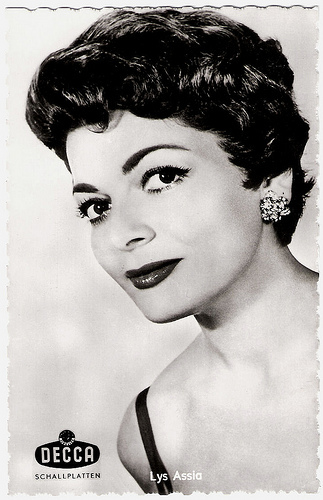
German postcard by Kolibri-Verlag, Minden/Westf., no. 2428. Photo: Teldec.
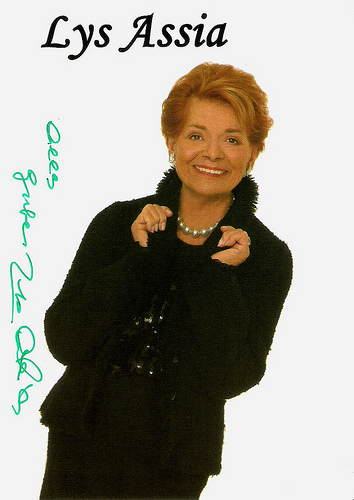
German card by LYSassia.de. Publicity card for the album Sehnsucht nach dir. Photo: Gerd Nolte.
Legendary Venues
Lys Assia was born as Rosa Mina Schärer in Rupperswil in the canton Aargau, Switzerland, in 1924 (some sources indicate she was born in Berne in 1926).
She studied at a conservatory and at the art academy of Zurich. At 16, she started her career as a dancer at Zurich's Corso-Palast.
In 1940, she appeared with the Riva-Ballett for the French army, and in Nice she stood in for a female singer. People who heard her singing liked it so much that she decided for a career in front of the microphone.
In 1942 she had her first record contract with His Master’s Voice. She had her breakthrough in Germany in 1950 with the hit song O mein Papa (O My Father) from the operetta Feuerwerk (Fire Works) by Paul Burkhard.
Other well known songs of her were Moulin Rouge (1953), Schwedenmädel (Swedish Girl) (1954), Jolie Jacqueline (1955), Arrivederci Roma (1956), Was kann schöner sein (What Can Be More Beautiful?) (1956), Deine Liebe (Your Love) (1957) and Mi casa su casa (1957).
She sang in such legendary venues as the Tivoli in Copenhagen, the Olympia in Paris, the Plaza in New York and the Tropicana in Cuba.
On screen she appeared as a Schlager singer in German films like Palace Hotel (Emil Berna, Leonard Steckel, 1952) with Paul Hubschmid , Illusion in Moll/Illusion in a Minor Key (Rudolf Jugert, 1952) starring Hildegard Knef , Schlagerparade/Hit Parade (Erik Ode, 1953), Ein Mann Vergißt die Liebe/A Man Forgets Love (Volker von Collande, 1955) and Die Beine von Dolores/Dolores' Legs (Géza von Cziffra, 1957) with Germaine Damar .
In the Italian classic Le Notti Bianchi/White Nights (Luchino Visconti, 1957 - yes, we think every Visconti film is a classic

German postcard by Kolibri-Verlag, Minden/Westf., no. 2428. Photo: Teldec.

German card by LYSassia.de. Publicity card for the album Sehnsucht nach dir. Photo: Gerd Nolte.
Legendary Venues
Lys Assia was born as Rosa Mina Schärer in Rupperswil in the canton Aargau, Switzerland, in 1924 (some sources indicate she was born in Berne in 1926).
She studied at a conservatory and at the art academy of Zurich. At 16, she started her career as a dancer at Zurich's Corso-Palast.
In 1940, she appeared with the Riva-Ballett for the French army, and in Nice she stood in for a female singer. People who heard her singing liked it so much that she decided for a career in front of the microphone.
In 1942 she had her first record contract with His Master’s Voice. She had her breakthrough in Germany in 1950 with the hit song O mein Papa (O My Father) from the operetta Feuerwerk (Fire Works) by Paul Burkhard.
Other well known songs of her were Moulin Rouge (1953), Schwedenmädel (Swedish Girl) (1954), Jolie Jacqueline (1955), Arrivederci Roma (1956), Was kann schöner sein (What Can Be More Beautiful?) (1956), Deine Liebe (Your Love) (1957) and Mi casa su casa (1957).
She sang in such legendary venues as the Tivoli in Copenhagen, the Olympia in Paris, the Plaza in New York and the Tropicana in Cuba.
On screen she appeared as a Schlager singer in German films like Palace Hotel (Emil Berna, Leonard Steckel, 1952) with Paul Hubschmid , Illusion in Moll/Illusion in a Minor Key (Rudolf Jugert, 1952) starring Hildegard Knef , Schlagerparade/Hit Parade (Erik Ode, 1953), Ein Mann Vergißt die Liebe/A Man Forgets Love (Volker von Collande, 1955) and Die Beine von Dolores/Dolores' Legs (Géza von Cziffra, 1957) with Germaine Damar .
In the Italian classic Le Notti Bianchi/White Nights (Luchino Visconti, 1957 - yes, we think every Visconti film is a classic
Published on March 24, 2018 18:00
Paul van Yperen's Blog
- Paul van Yperen's profile
- 13 followers
Paul van Yperen isn't a Goodreads Author
(yet),
but they
do have a blog,
so here are some recent posts imported from
their feed.



